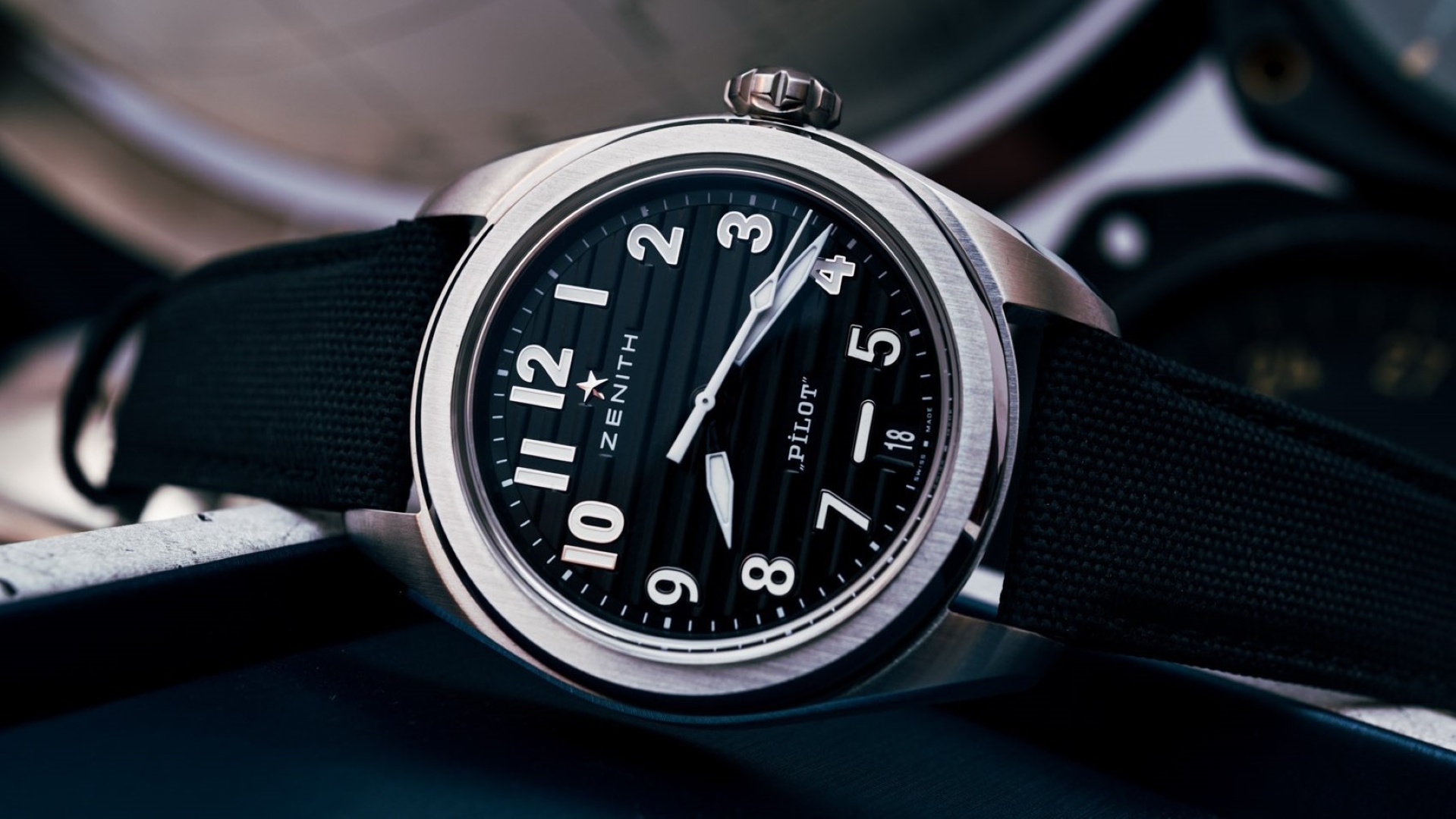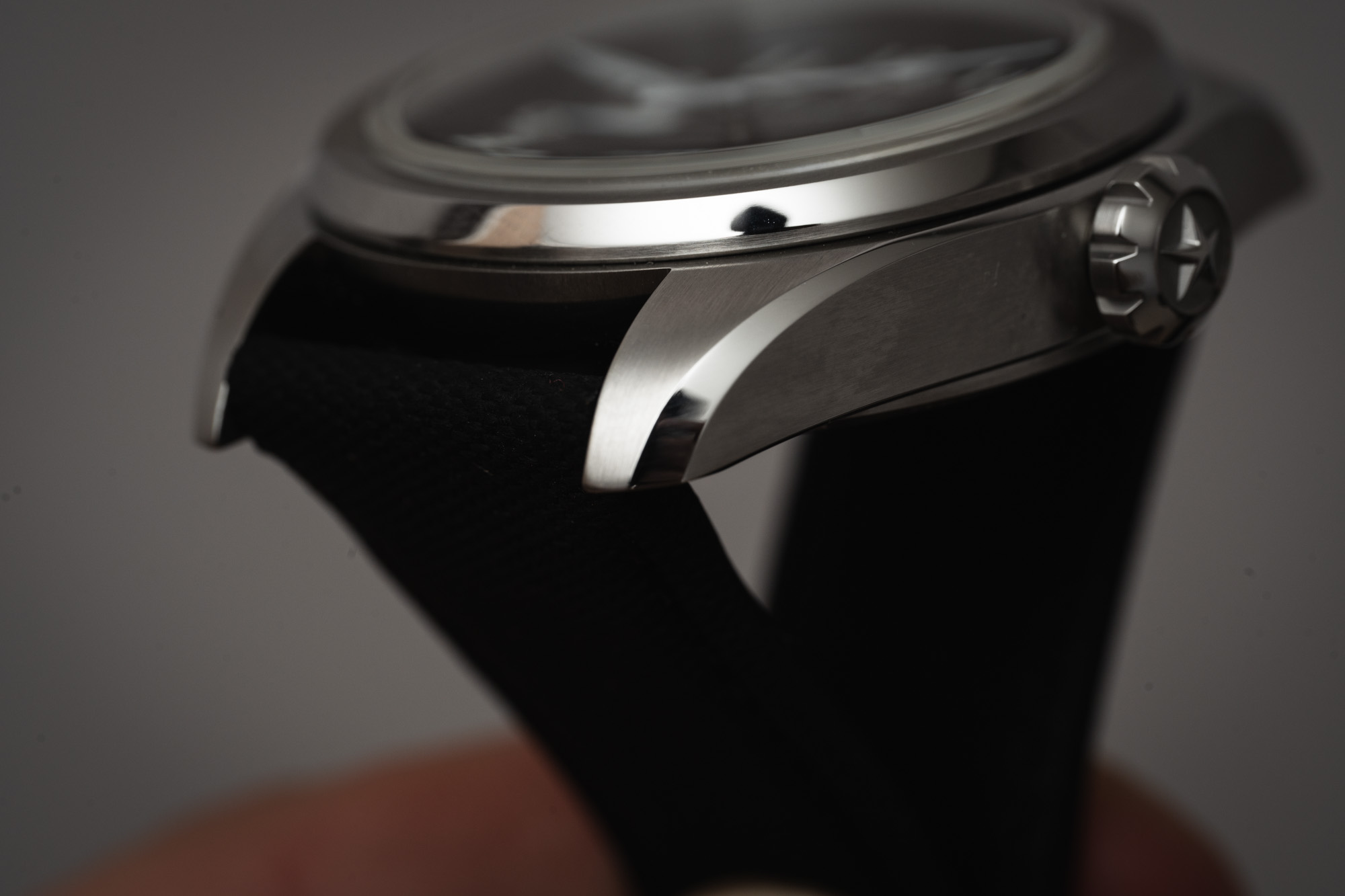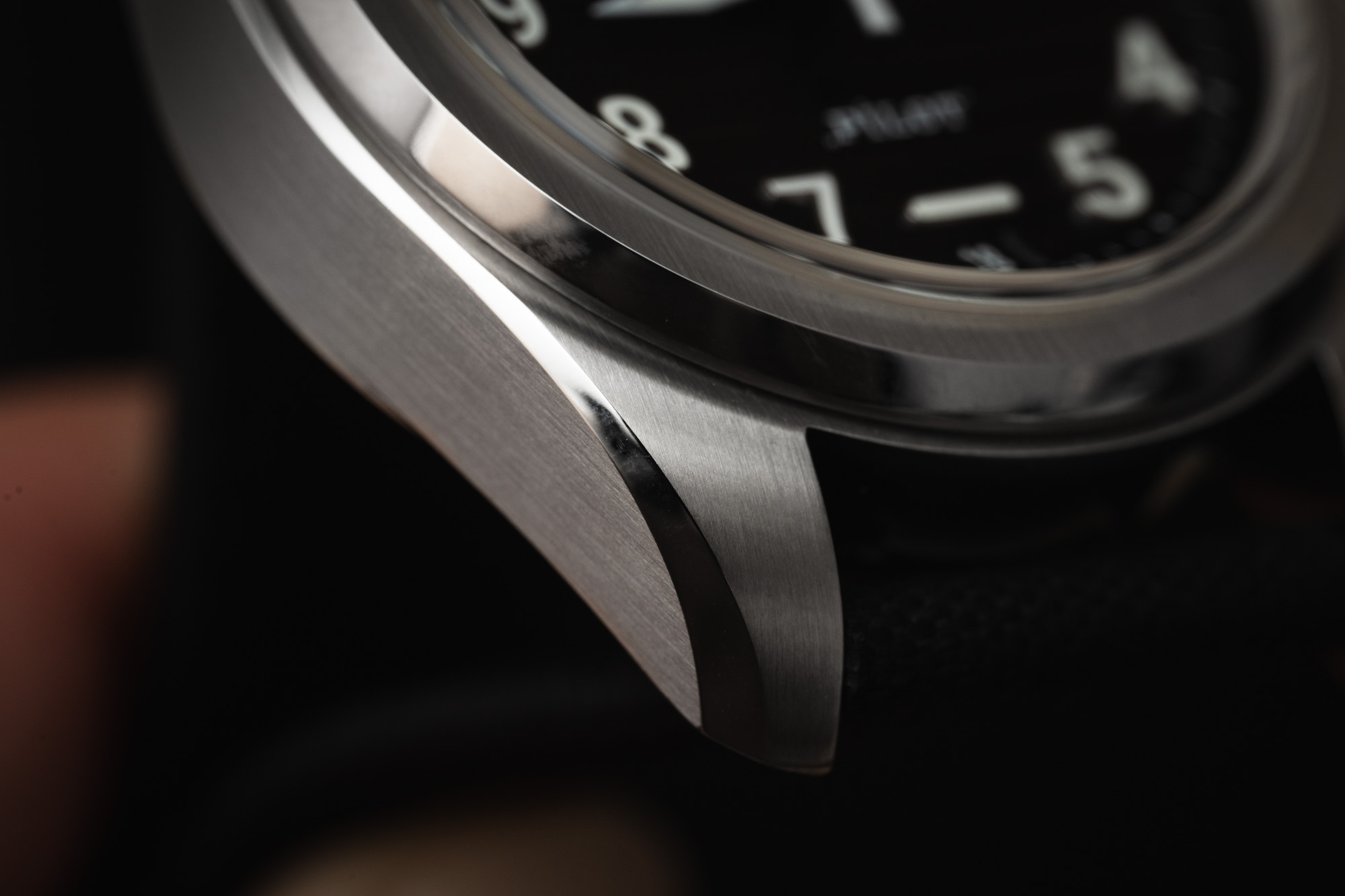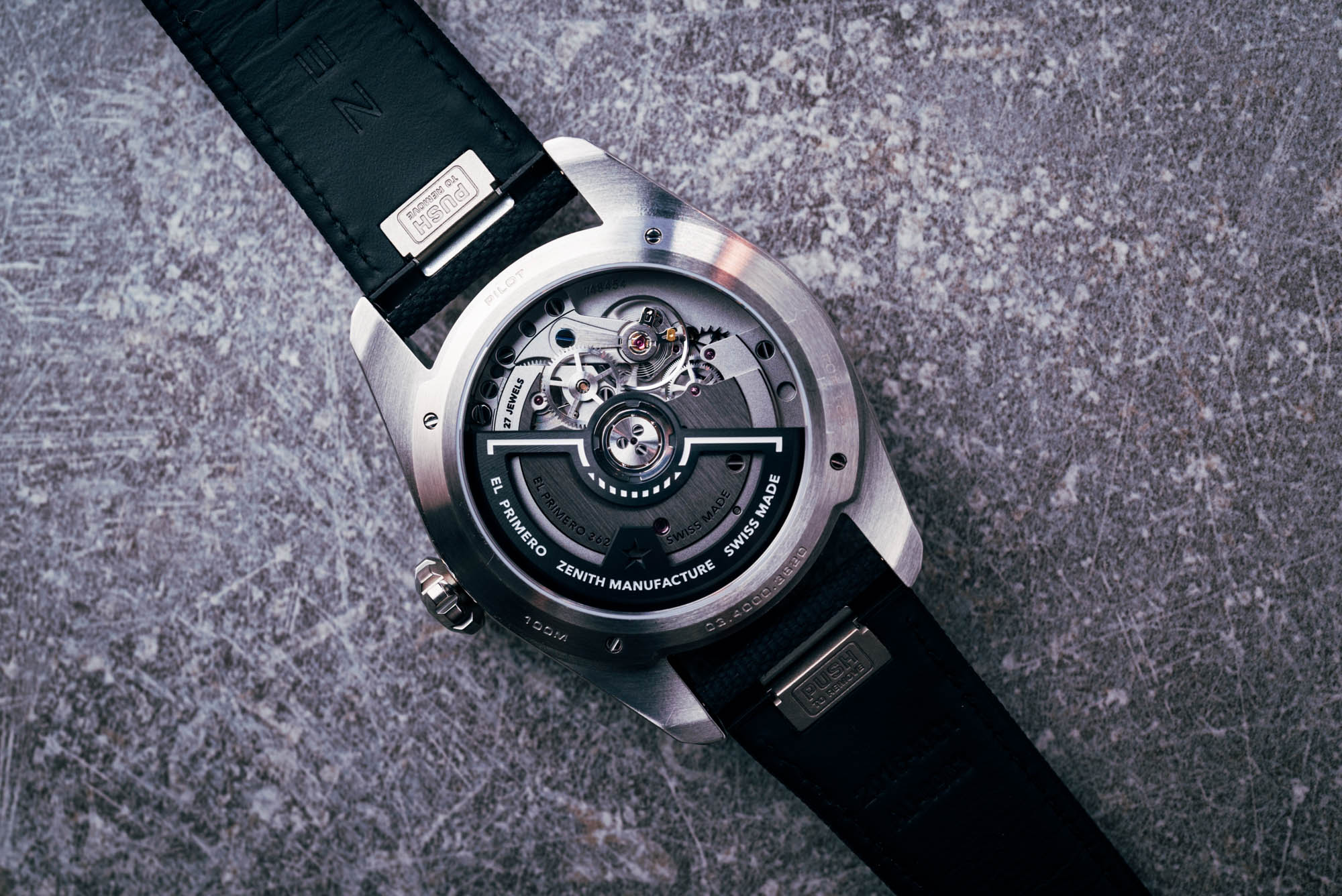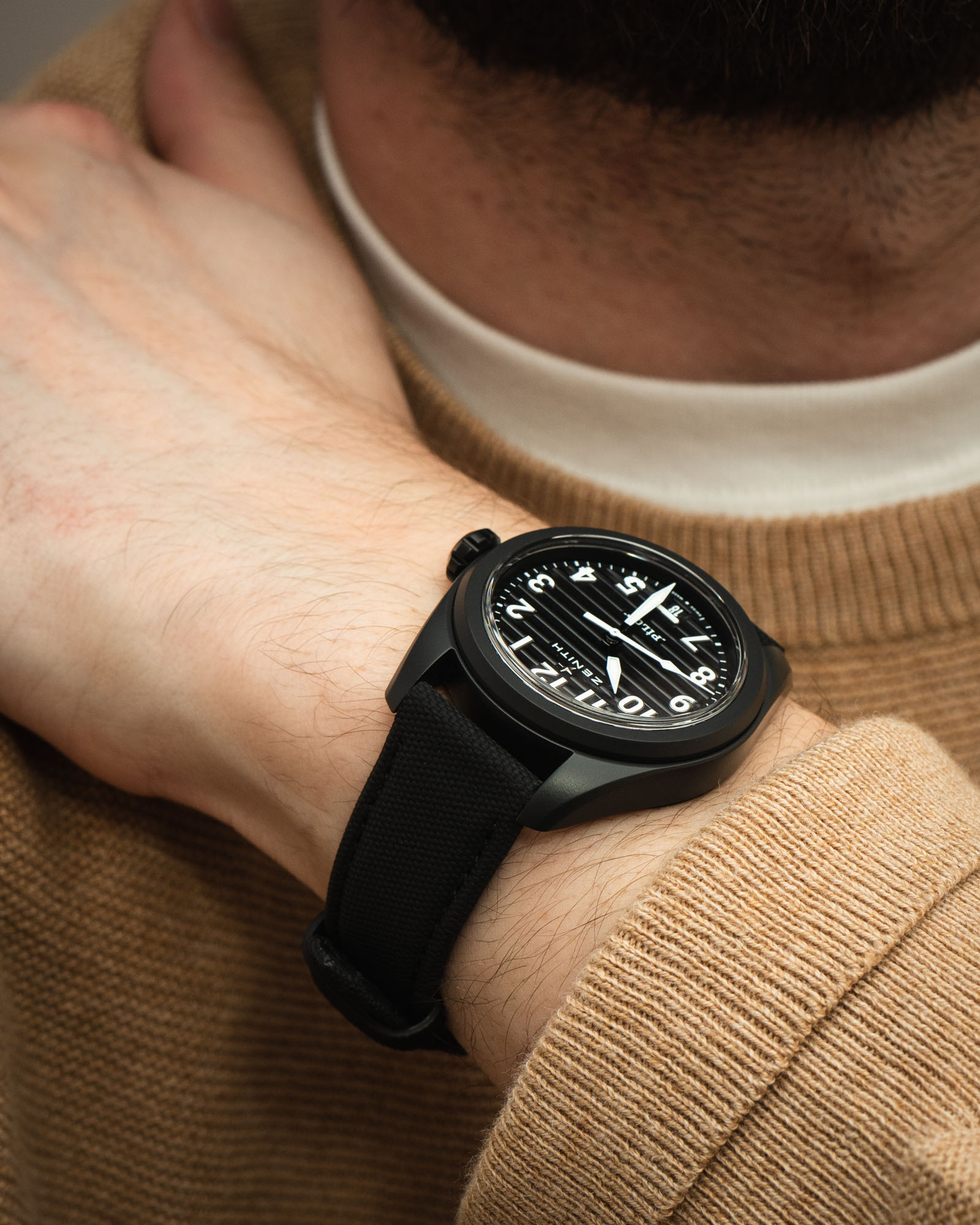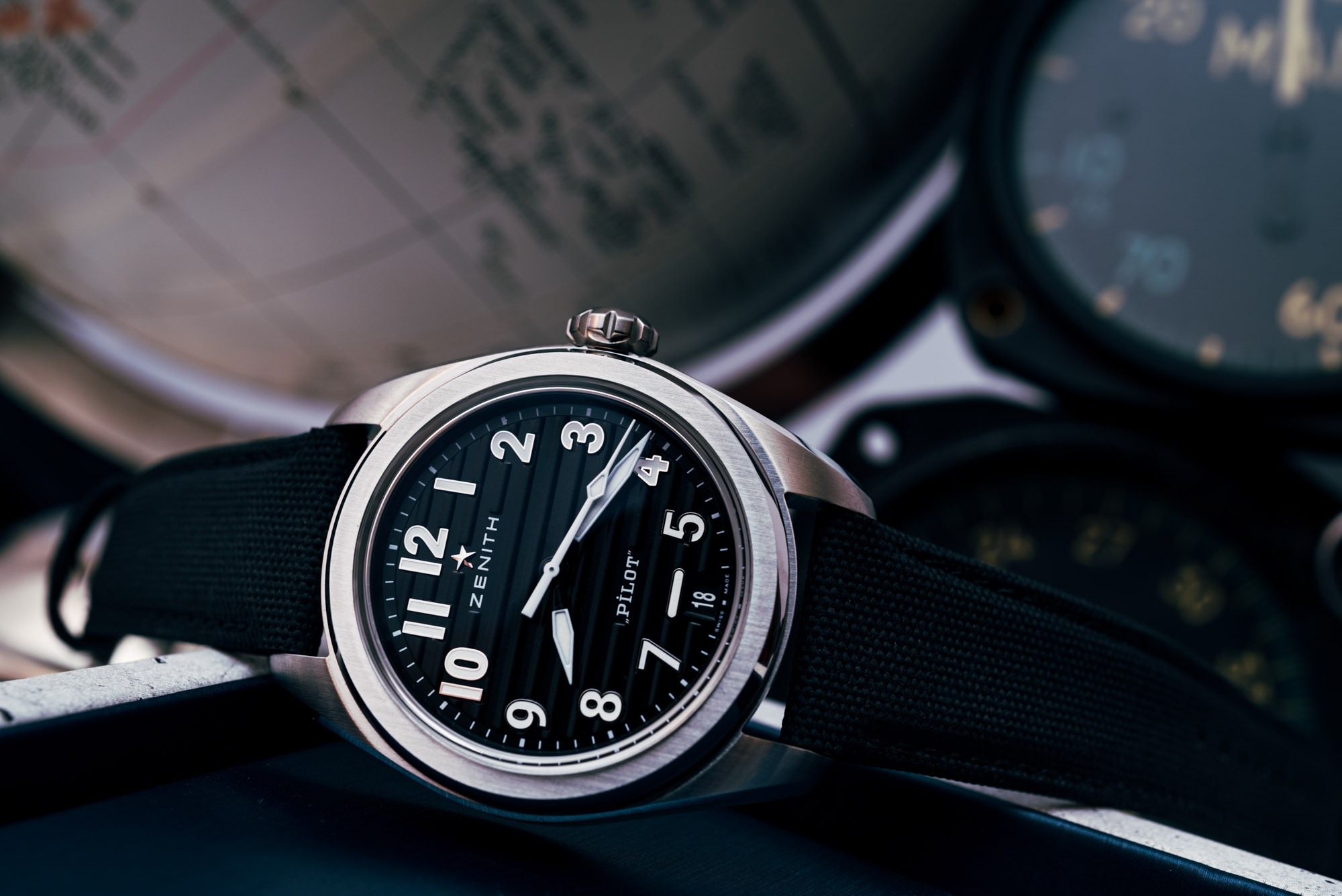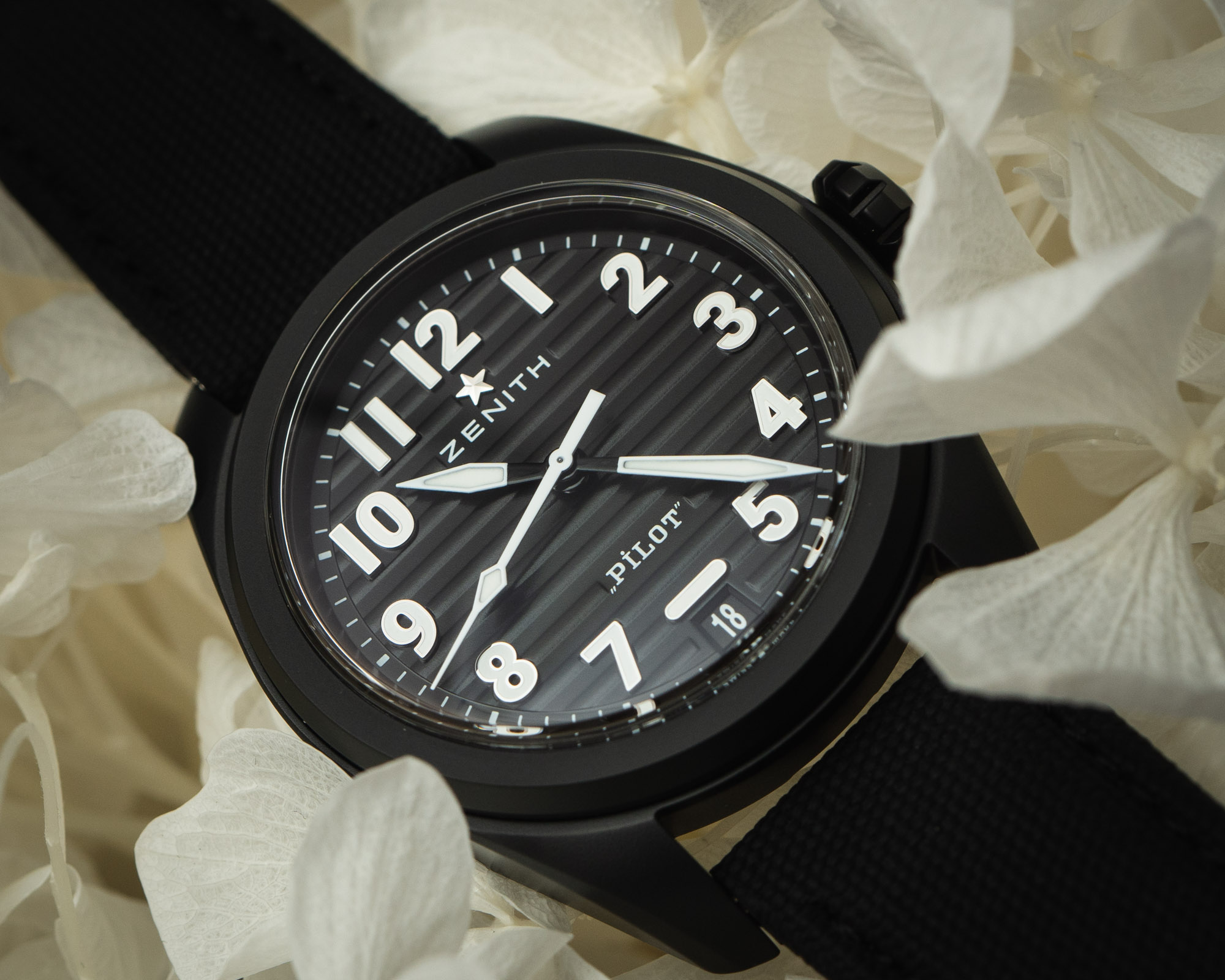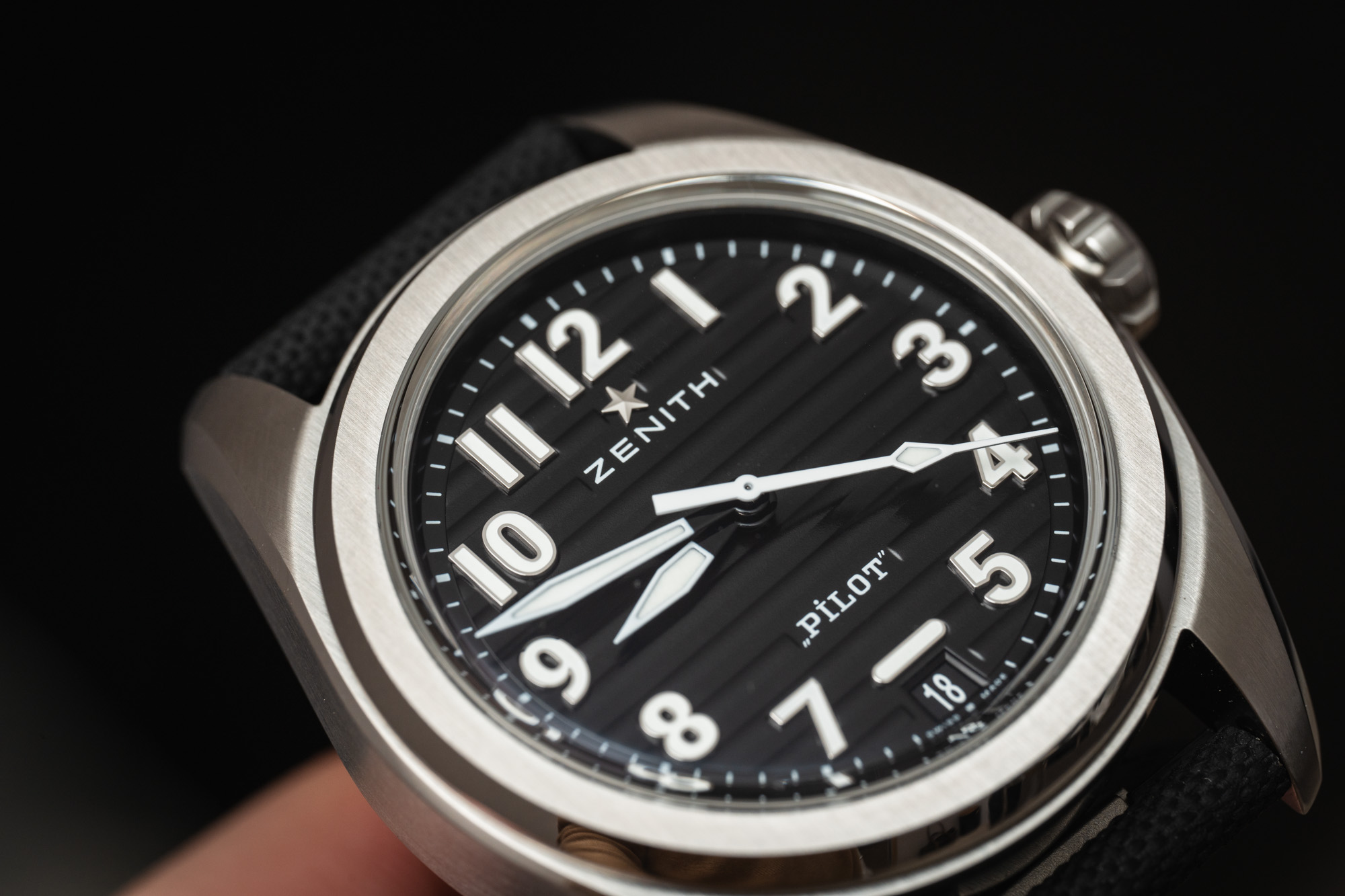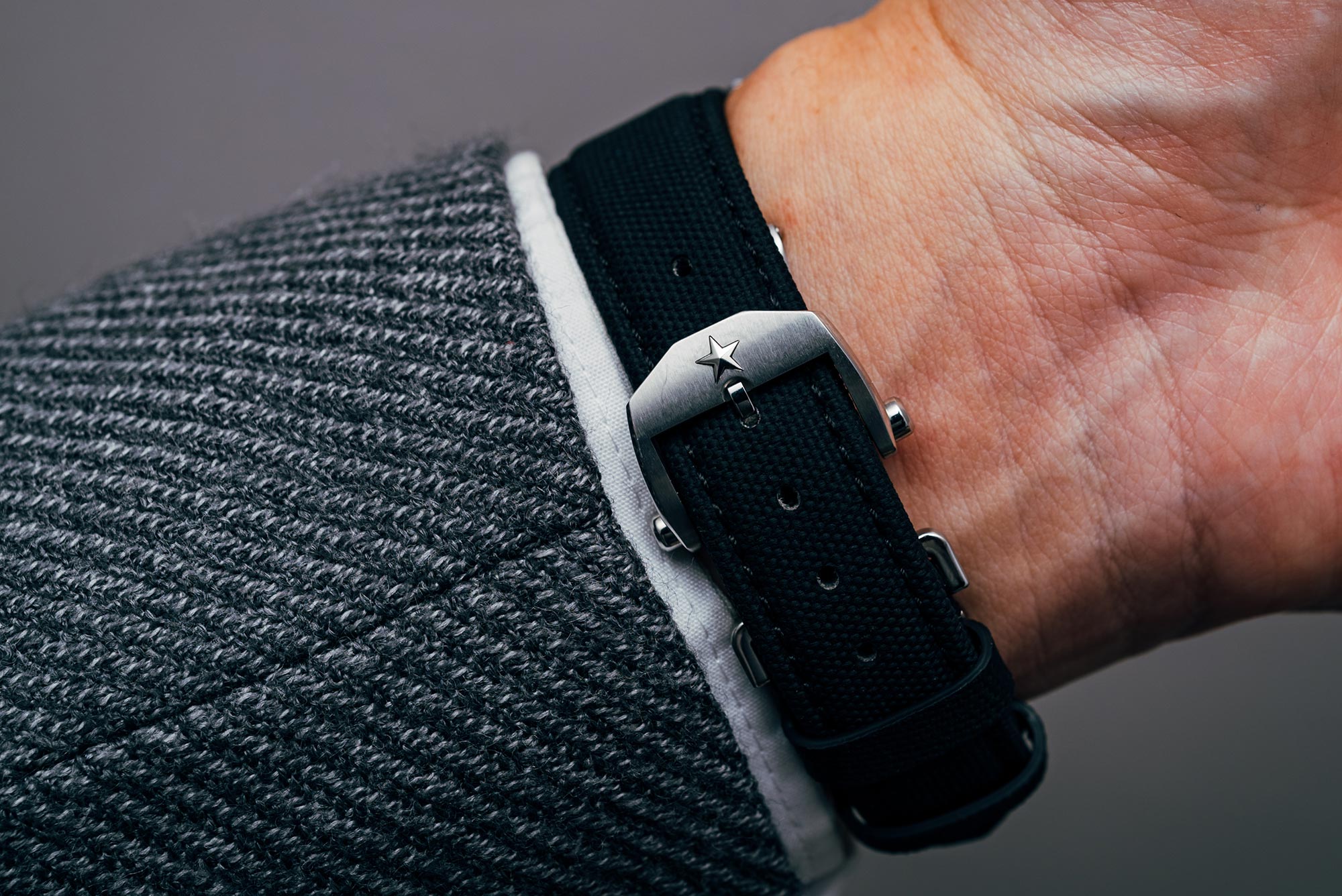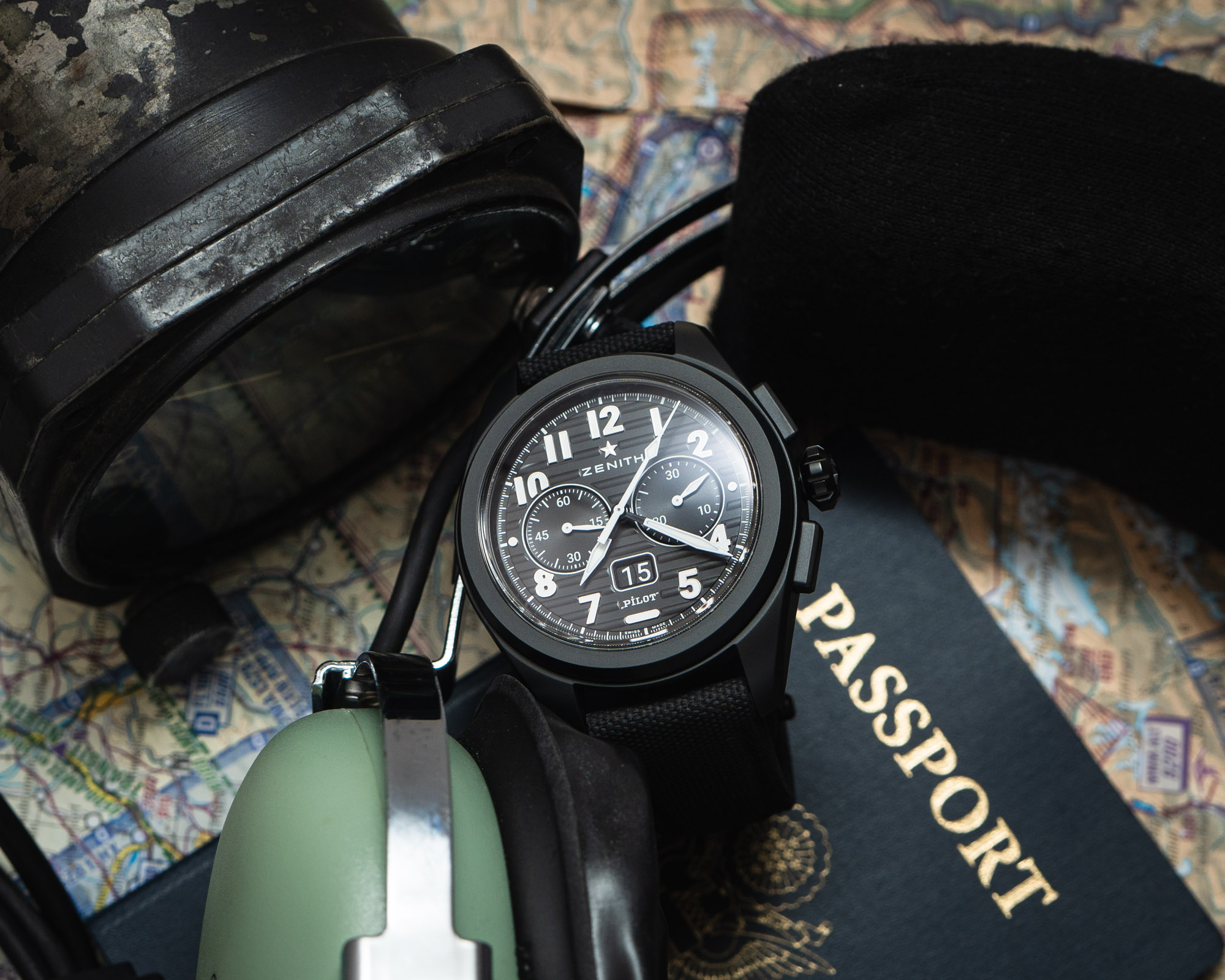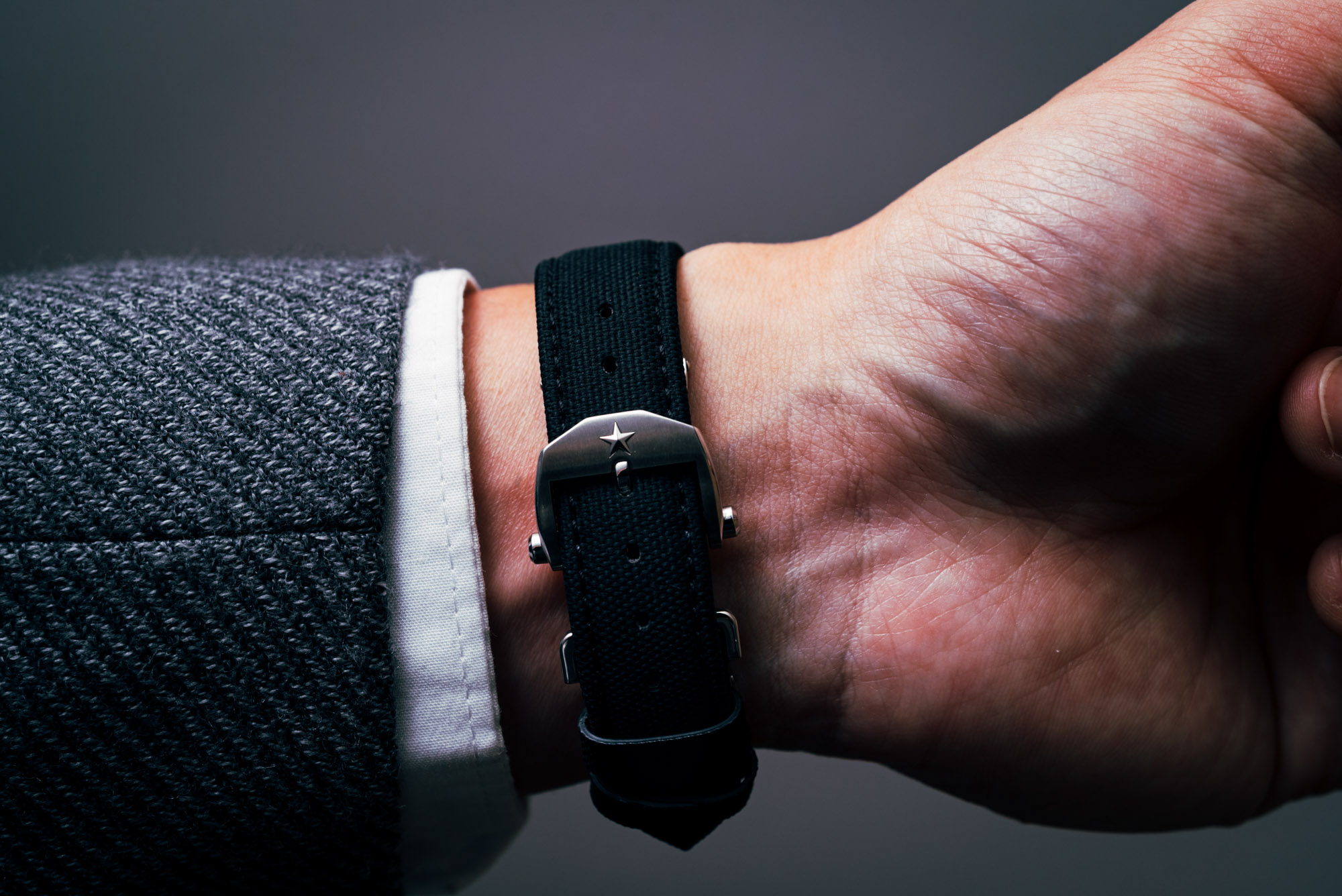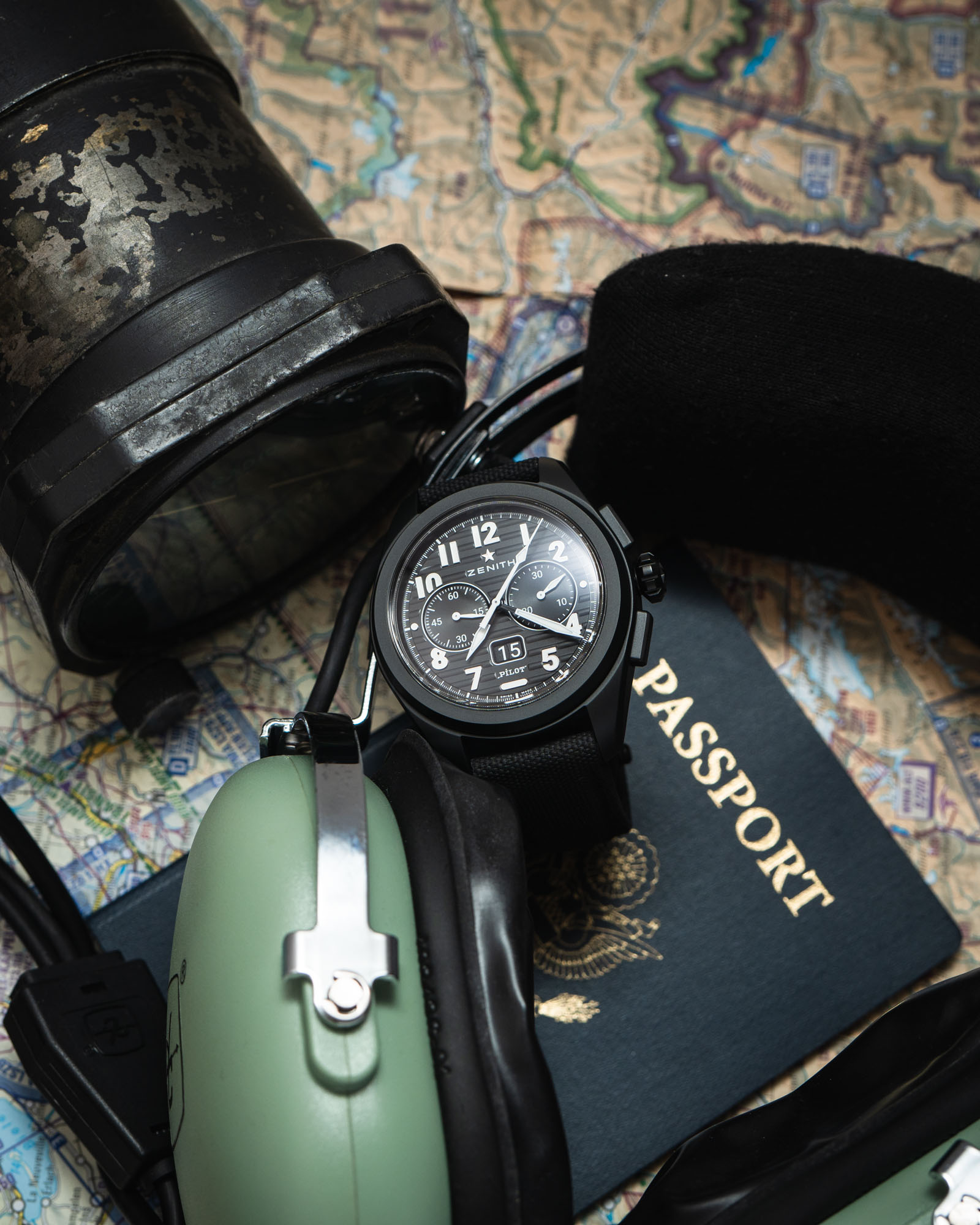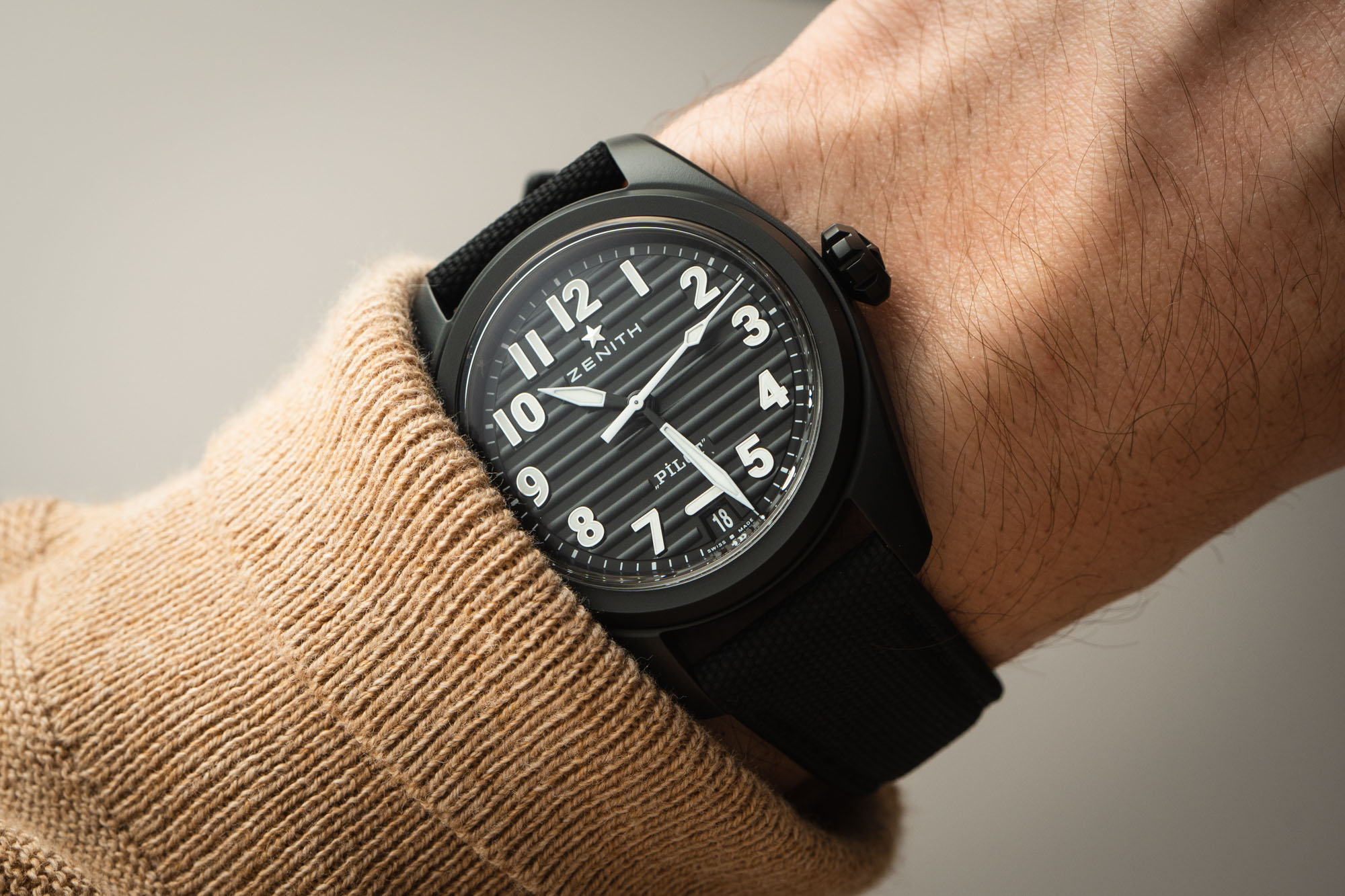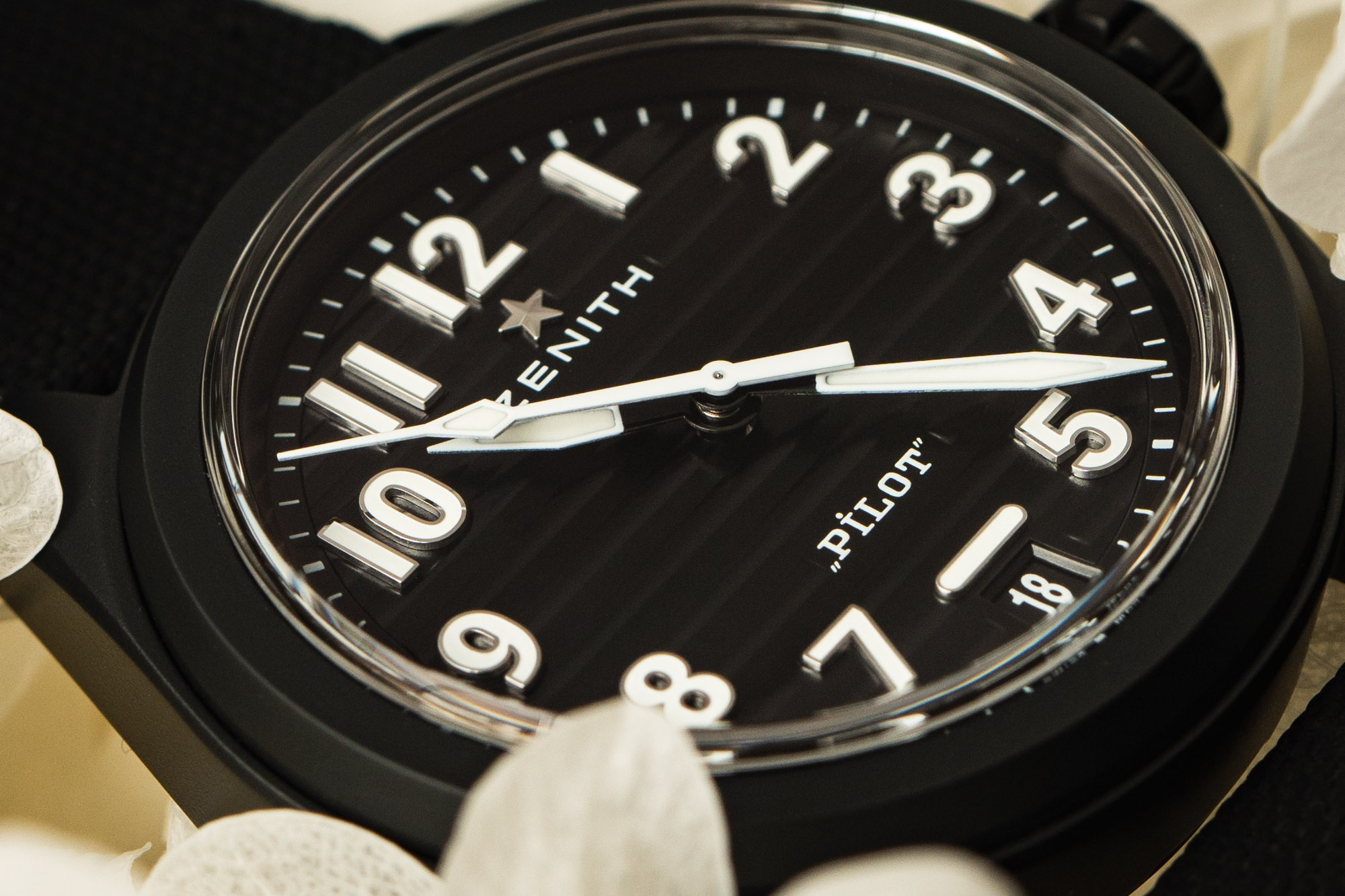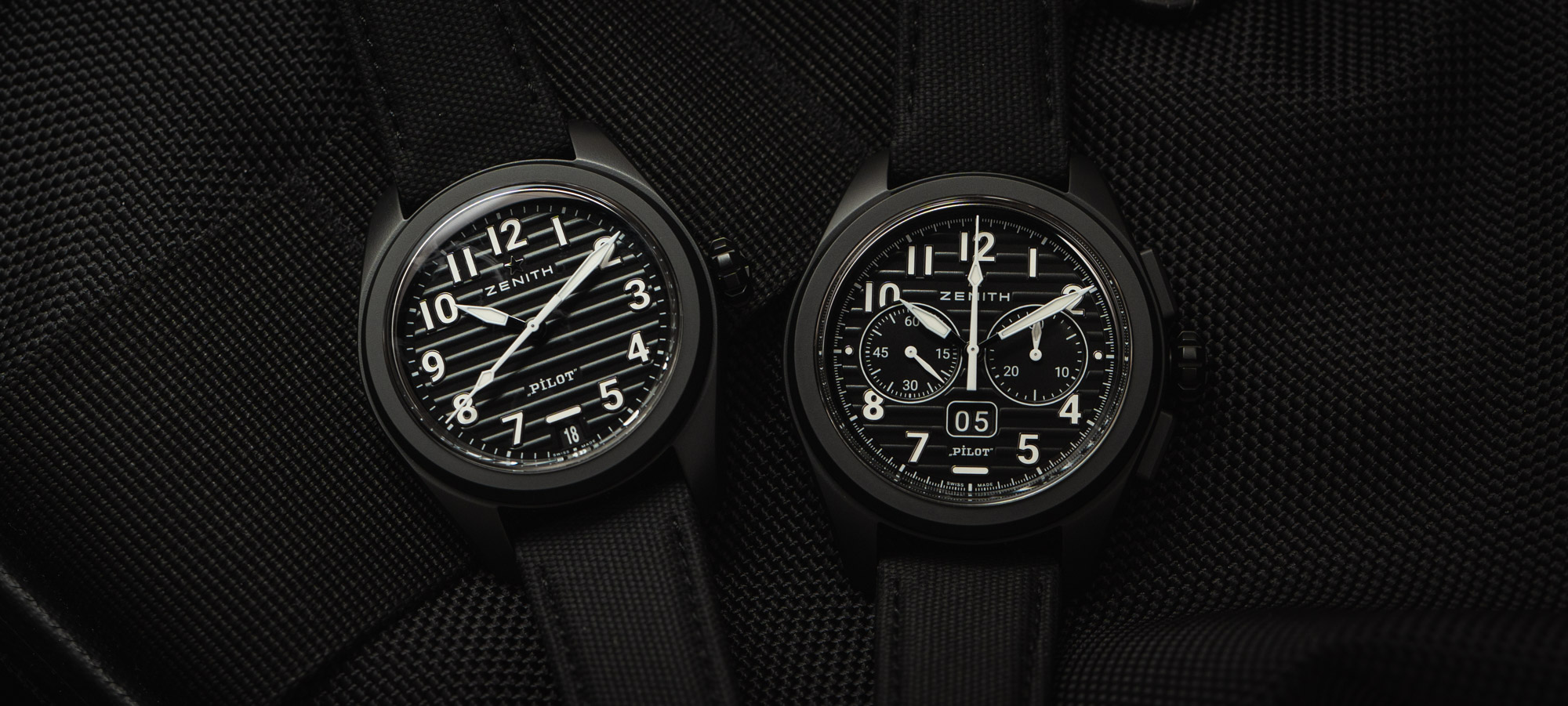 The dearth of Zenith pilot watches always struck me as odd. Here is a brand that has made aircraft clocks (and altimeters and stopwatches) and pilot’s chronographs supplied to the Italian military, and even has a trademark on using the word “pilot” in the name or on the dial of a watch. After a decades-long hiatus, it started up again in 2009, and from then, there was a slow trickle of Type 20s and an even slower trickle of other pilot-style watches. With the release of the Defy collection and the refresh of the Chronomaster, it seemed that the tap had been shut off for Zenith’s pilot watches. It’s been almost three years since we saw a new model—what happened? This year at Watches and Wonders 2023 we found out: Zenith had been hard at work on a complete redesign of the collection. The all-new Zenith Pilot collection includes the Zenith Pilot Big Date Flyback chronograph and the Zenith Pilot Automatic three-hander, both available in either steel or ceramic. I’ll not bury the lede any further: They’re fantastic.
The dearth of Zenith pilot watches always struck me as odd. Here is a brand that has made aircraft clocks (and altimeters and stopwatches) and pilot’s chronographs supplied to the Italian military, and even has a trademark on using the word “pilot” in the name or on the dial of a watch. After a decades-long hiatus, it started up again in 2009, and from then, there was a slow trickle of Type 20s and an even slower trickle of other pilot-style watches. With the release of the Defy collection and the refresh of the Chronomaster, it seemed that the tap had been shut off for Zenith’s pilot watches. It’s been almost three years since we saw a new model—what happened? This year at Watches and Wonders 2023 we found out: Zenith had been hard at work on a complete redesign of the collection. The all-new Zenith Pilot collection includes the Zenith Pilot Big Date Flyback chronograph and the Zenith Pilot Automatic three-hander, both available in either steel or ceramic. I’ll not bury the lede any further: They’re fantastic.
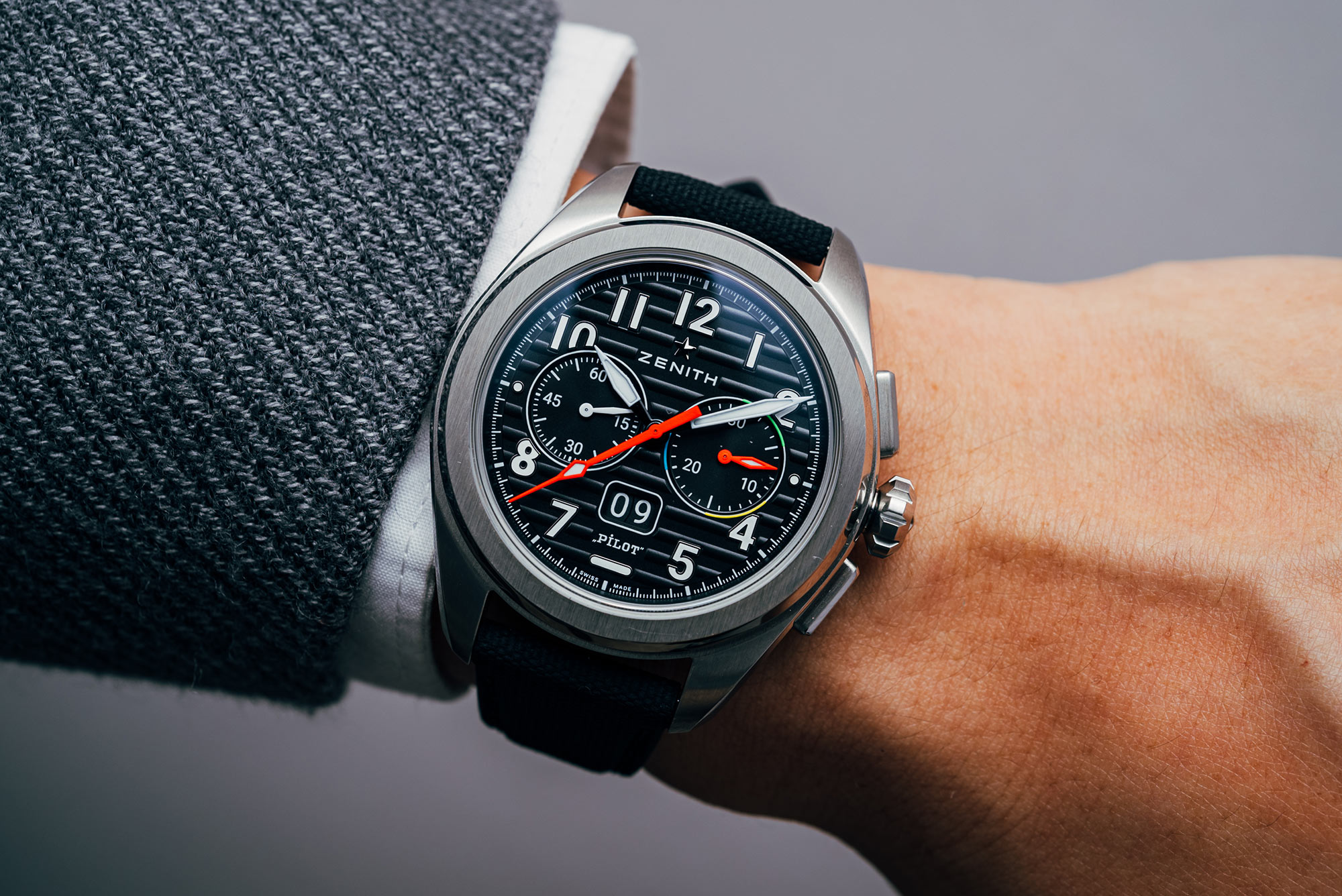
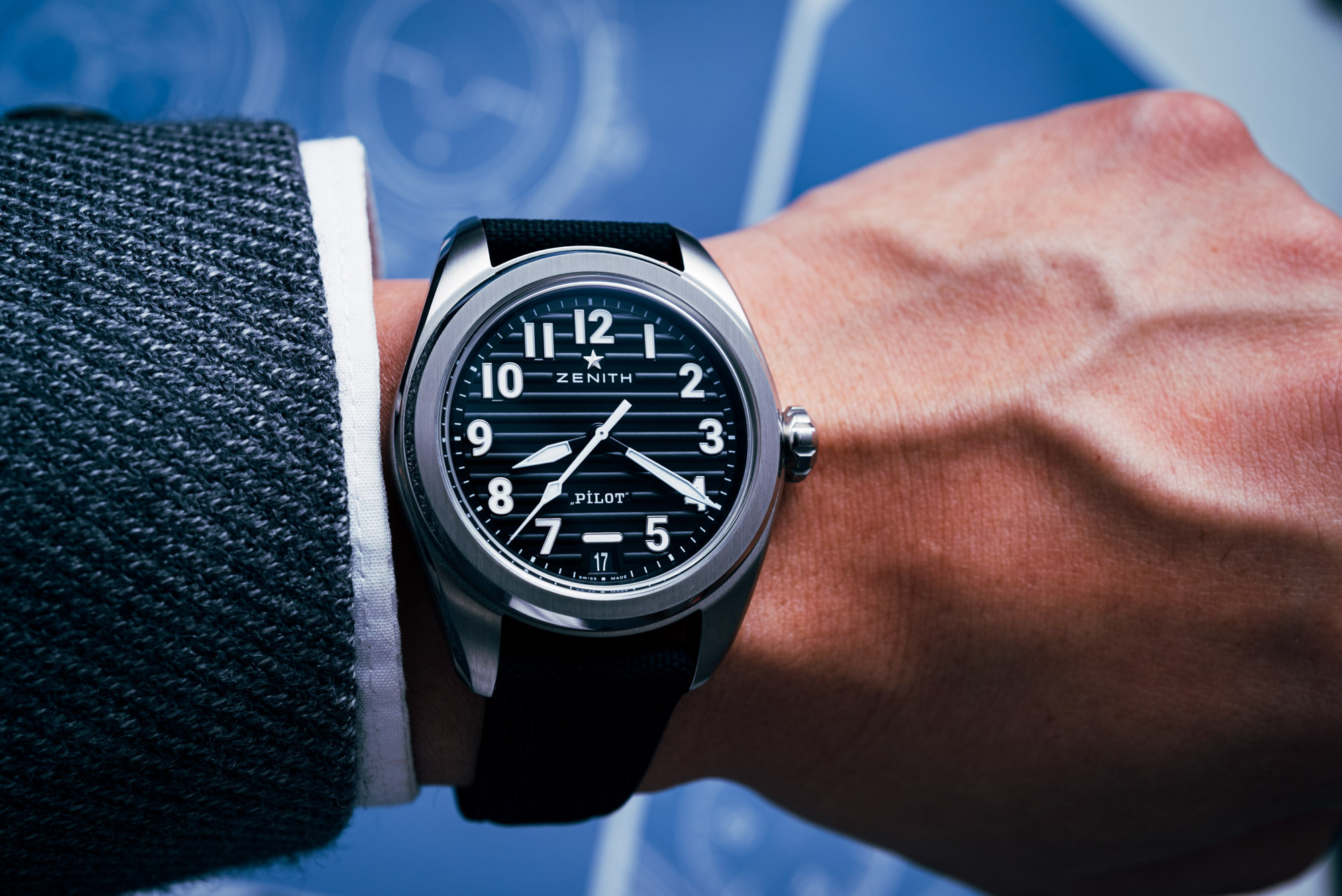 To call this new collection of Pilots a revision or overhaul is to ignore the fact that almost everything on the watch is new not just to the collection, but to the brand. Save for the Zenith star and the Pilot text, we have a new case, new crown, new dials, new straps, and, in the chronographs, a new movement. The watches are offered in either stainless steel or black ceramic, the former of which is predominantly brushed with polished accents, and the latter of which is fully micro-blasted. The Automatic cases measure 40mm, while the chronos clock in at 42.5mm. Given that previous iterations have pushed 45mm, this is a welcome reduction.
To call this new collection of Pilots a revision or overhaul is to ignore the fact that almost everything on the watch is new not just to the collection, but to the brand. Save for the Zenith star and the Pilot text, we have a new case, new crown, new dials, new straps, and, in the chronographs, a new movement. The watches are offered in either stainless steel or black ceramic, the former of which is predominantly brushed with polished accents, and the latter of which is fully micro-blasted. The Automatic cases measure 40mm, while the chronos clock in at 42.5mm. Given that previous iterations have pushed 45mm, this is a welcome reduction.
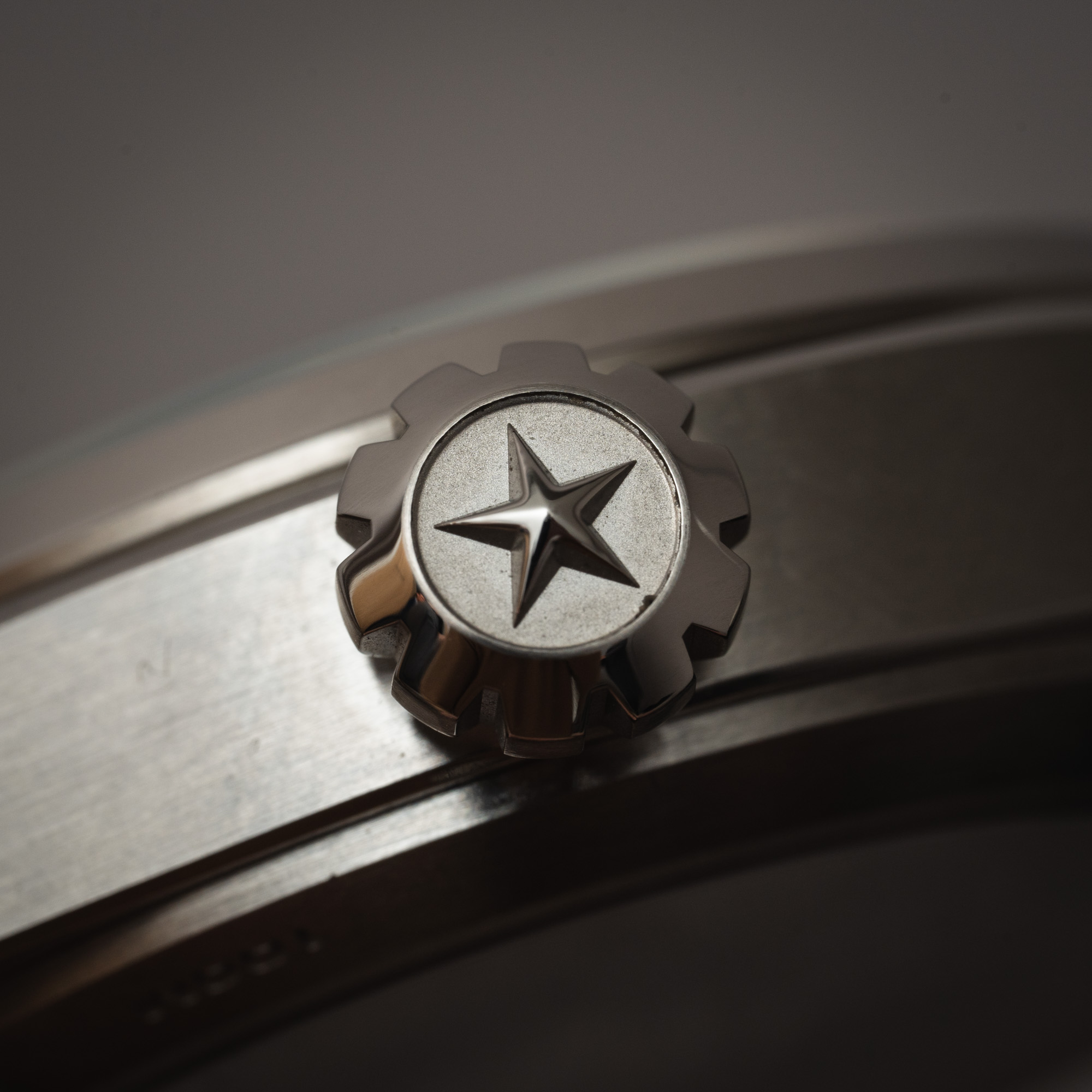 Admittedly, this case isn’t changing the entire game, just the Zenith Pilot game. It’s a welcome upgrade, but it’s somehow familiar, even if it’s new; there are other sporty watch designs that have a gently curved silhouette with chamfers, and almost all ceramic watches are similarly finished and look modern. Between the two cases here, the black ceramic looks and feels more contemporary, but the steel doesn’t play dated in any way. The cases both have box sapphire crystals and 100m of water resistance, but my favorite part of the case was the redesigned pilot’s crown. Unlike Zenith’s old pilots, though, it isn’t enormous, instead being in perfect proportion with the case. It’s also been modernized with fewer grooves, giving it a sparser, sleeker look. Of course, it’s still easy to grip and operate (but more on that in a bit), just like the pushers on the chronograph.
Admittedly, this case isn’t changing the entire game, just the Zenith Pilot game. It’s a welcome upgrade, but it’s somehow familiar, even if it’s new; there are other sporty watch designs that have a gently curved silhouette with chamfers, and almost all ceramic watches are similarly finished and look modern. Between the two cases here, the black ceramic looks and feels more contemporary, but the steel doesn’t play dated in any way. The cases both have box sapphire crystals and 100m of water resistance, but my favorite part of the case was the redesigned pilot’s crown. Unlike Zenith’s old pilots, though, it isn’t enormous, instead being in perfect proportion with the case. It’s also been modernized with fewer grooves, giving it a sparser, sleeker look. Of course, it’s still easy to grip and operate (but more on that in a bit), just like the pushers on the chronograph.
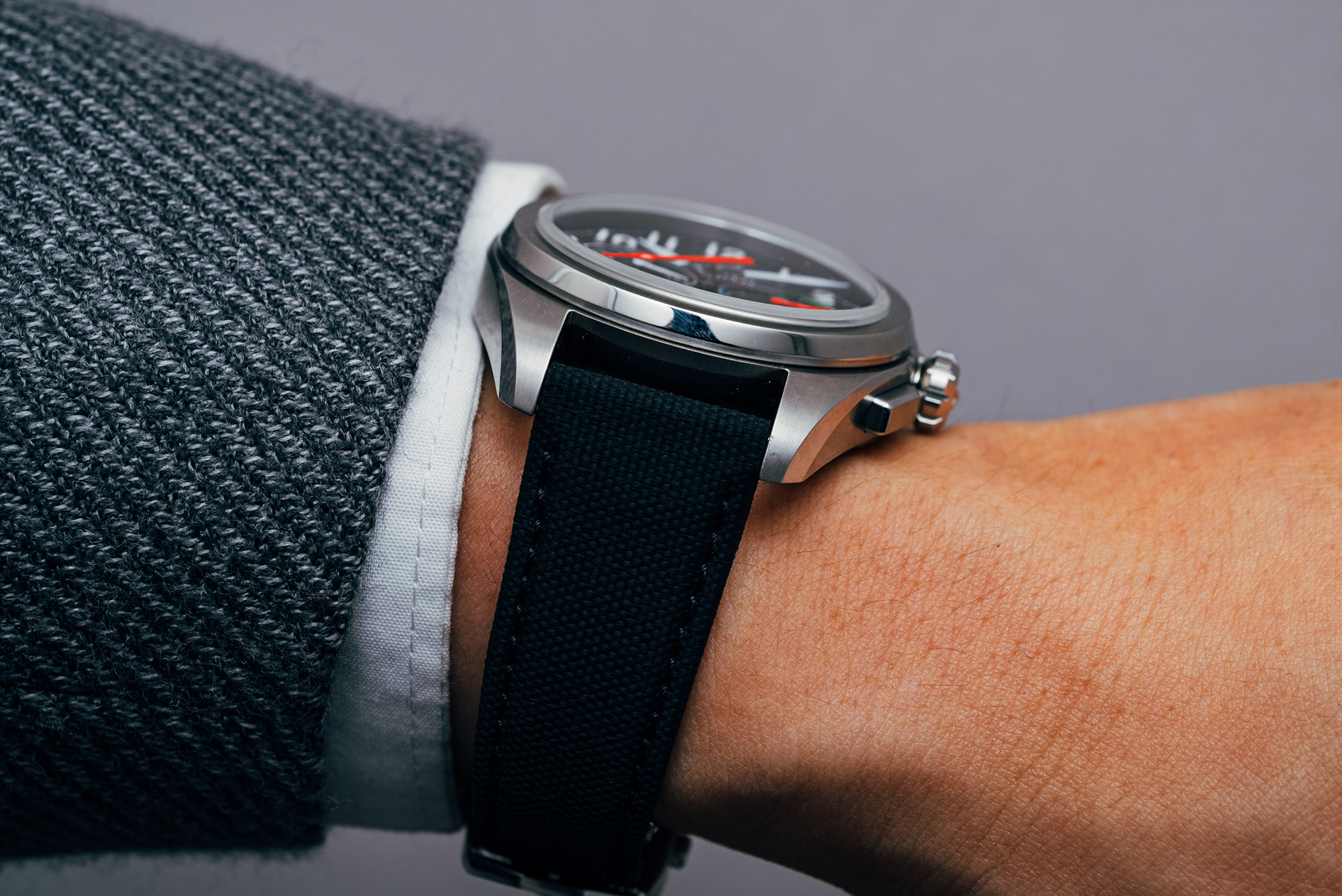 42.5mm may be on the large side for some, but considering it’s an automatic chrono, I had no complaints. I do wish the underside of the lugs curved down a bit more, though, to let the watch hug the wrist a bit better. As it is, you do get a bit of a flat wear, but the watch is not as overlarge as its predecessors, so even with that flatness, it doesn’t stand out too much. It also helps that instead of the vintage wire lugs, this modern case has lugs that, on their tops, do have a generous curve; aesthetically, they slope down along the wrist, if that makes sense. The 40mm Automatic cases wear a bit better on account of their smaller size; the lug-to-lug is such that the flatter case doesn’t make itself quite as known.
42.5mm may be on the large side for some, but considering it’s an automatic chrono, I had no complaints. I do wish the underside of the lugs curved down a bit more, though, to let the watch hug the wrist a bit better. As it is, you do get a bit of a flat wear, but the watch is not as overlarge as its predecessors, so even with that flatness, it doesn’t stand out too much. It also helps that instead of the vintage wire lugs, this modern case has lugs that, on their tops, do have a generous curve; aesthetically, they slope down along the wrist, if that makes sense. The 40mm Automatic cases wear a bit better on account of their smaller size; the lug-to-lug is such that the flatter case doesn’t make itself quite as known.
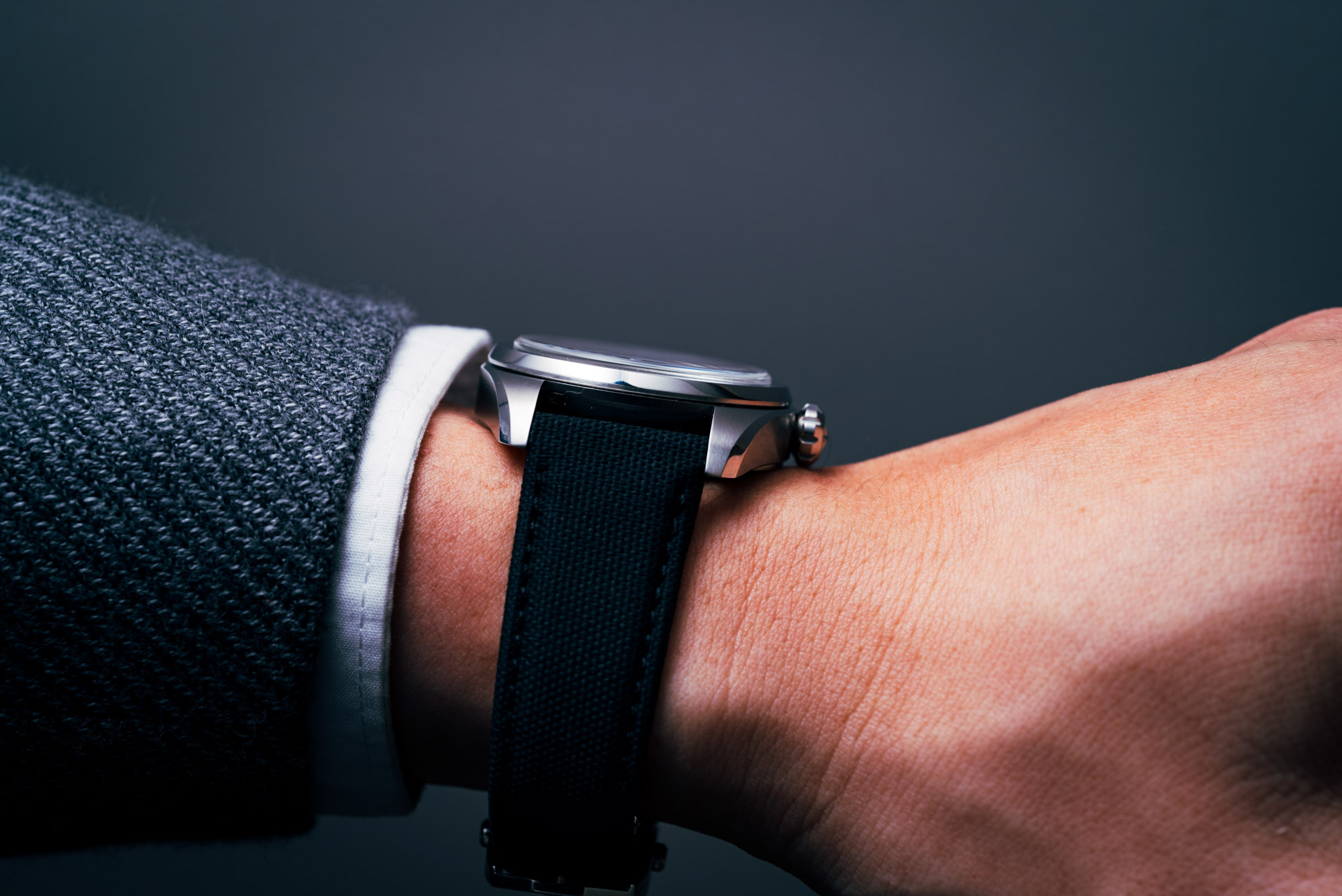 A black rubber strap with what the brand calls “Cordura effect” comes with all four models; I’m not sure what the effect was, because to me it certainly felt like Cordura or some equivalent. It was comfortable, if a bit stiff, and fitted with a trifold clasp that matched each case. The steel models will also come with a brown strap, while the black models will come with an extra khaki strap in the same FauxDura (my term, not the brand’s); I wasn’t able to try these straps, though. All the straps feature Zenith’s easy-release system, where all you have to do is depress the button at the end of the strap and it unclamps/clamps around the existing springbar. Note that the springbar can be removed to accommodate your own straps. My only critique is that I would have liked to have the ends of the included straps fitted to the case instead of traditional straight ends.
A black rubber strap with what the brand calls “Cordura effect” comes with all four models; I’m not sure what the effect was, because to me it certainly felt like Cordura or some equivalent. It was comfortable, if a bit stiff, and fitted with a trifold clasp that matched each case. The steel models will also come with a brown strap, while the black models will come with an extra khaki strap in the same FauxDura (my term, not the brand’s); I wasn’t able to try these straps, though. All the straps feature Zenith’s easy-release system, where all you have to do is depress the button at the end of the strap and it unclamps/clamps around the existing springbar. Note that the springbar can be removed to accommodate your own straps. My only critique is that I would have liked to have the ends of the included straps fitted to the case instead of traditional straight ends.
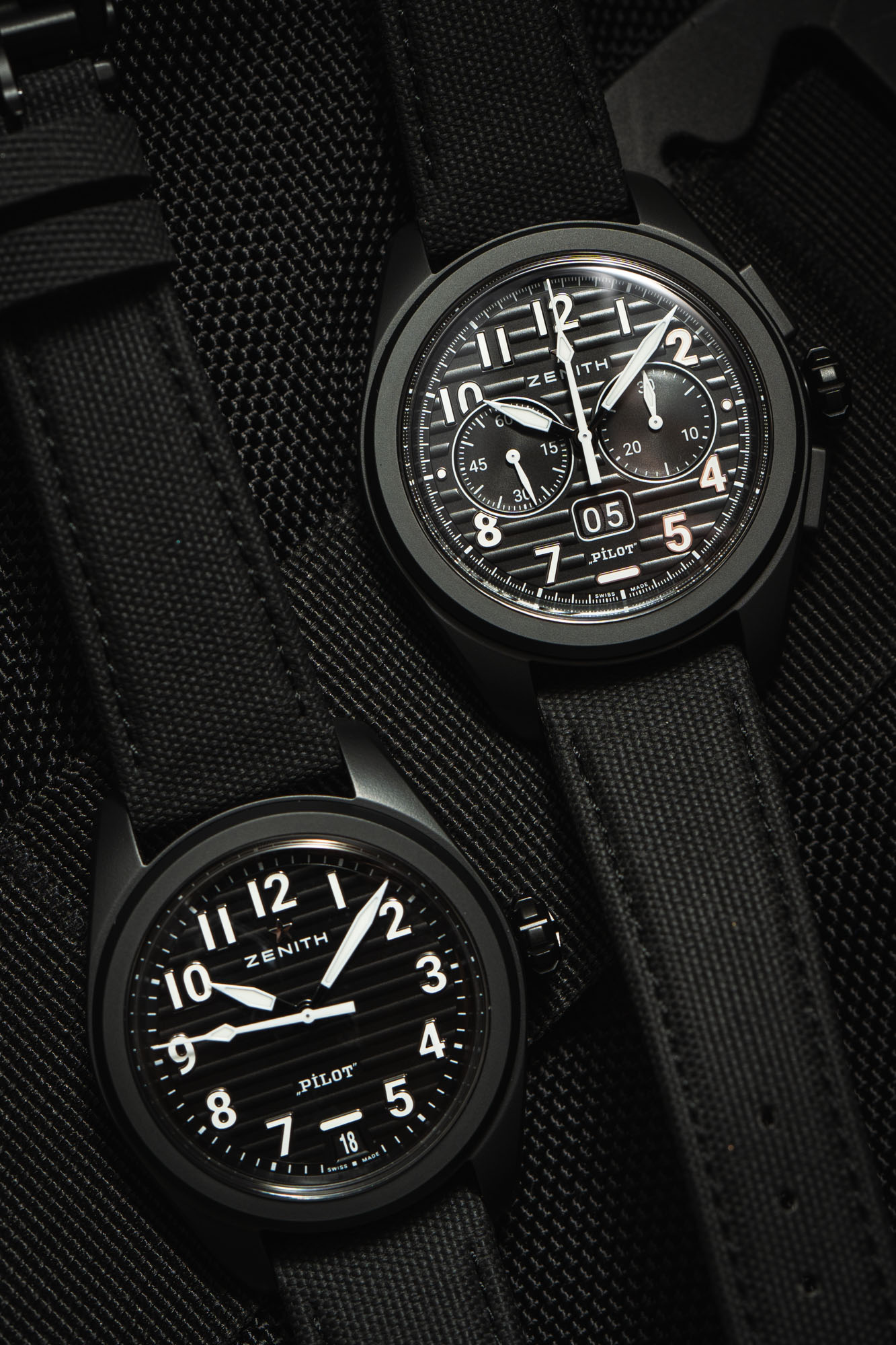 When I first got a look at the Zenith Pilot press release, I thought I was looking at a garage-door pattern dial similar to the Patek Philippe Nautilus, if a bit bolder. Both the Zenith Pilot Big Date Flyback and the Pilot Automatic, however, feature a heavy ribbed pattern in opaline black that takes its inspiration from the corrugated aluminum fuselages of early planes like the Ford Trimotor. What’s great about this is how the ridges play with the light: At rare angles, they can almost disappear, but then instantly come to life with the simple tilt or twist of the wrists. That’s the magic of the opaline finish of the dial, and along with the polished surrounds on the Super-LumiNova C1 Arabic numerals, it allows the dial to dance a bit. The markers have been updated from a vintage-inspired blocky serif to sleek, modern sans-serif numerals, which keeps them in line with the updated case design. On all the models, the stylized “Pilot” text that only Zenith can use on watches is the only holdover from the previous generations of Zenith Pilots.
When I first got a look at the Zenith Pilot press release, I thought I was looking at a garage-door pattern dial similar to the Patek Philippe Nautilus, if a bit bolder. Both the Zenith Pilot Big Date Flyback and the Pilot Automatic, however, feature a heavy ribbed pattern in opaline black that takes its inspiration from the corrugated aluminum fuselages of early planes like the Ford Trimotor. What’s great about this is how the ridges play with the light: At rare angles, they can almost disappear, but then instantly come to life with the simple tilt or twist of the wrists. That’s the magic of the opaline finish of the dial, and along with the polished surrounds on the Super-LumiNova C1 Arabic numerals, it allows the dial to dance a bit. The markers have been updated from a vintage-inspired blocky serif to sleek, modern sans-serif numerals, which keeps them in line with the updated case design. On all the models, the stylized “Pilot” text that only Zenith can use on watches is the only holdover from the previous generations of Zenith Pilots.
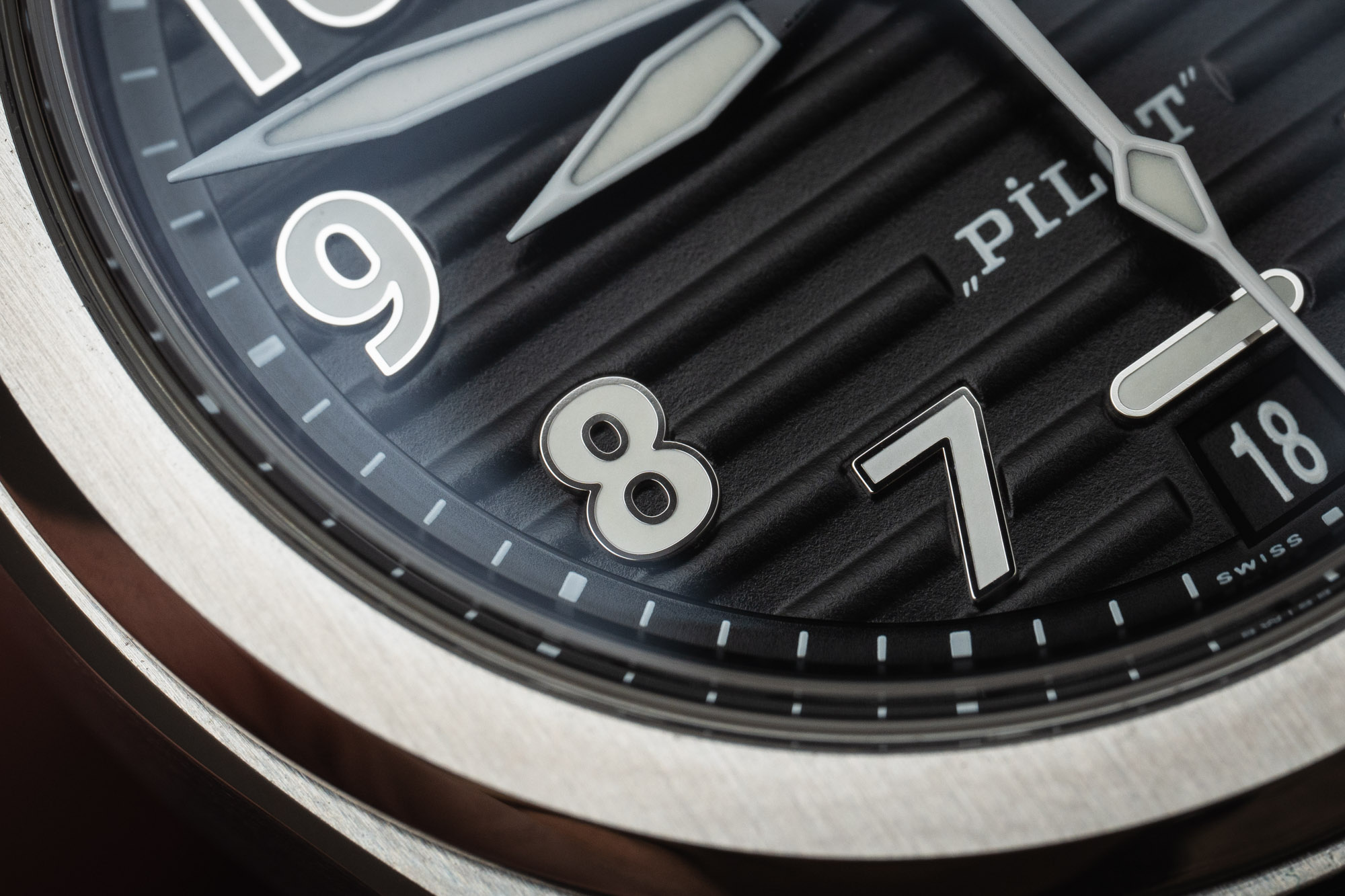 The Pilot Automatic dials are kept very simple. With the lumed cockpit instrument handsets and the white-on-black coloring, legibility is excellent. There’s no real clutter here, though I can see some griping about how the date and its adjacent lume plot are executed. Excepting for proper dive watches, more often than not, a brand will simply swap a lume plot for the date window. I’m happy that isn’t the case here and found the date window and the lume plot to be not just unobtrusive, but perfectly integrated into the dial design. The lume bar sits in line with one of the ridges while the date nestles right in underneath, just barely edging into the chapter ring.
The Pilot Automatic dials are kept very simple. With the lumed cockpit instrument handsets and the white-on-black coloring, legibility is excellent. There’s no real clutter here, though I can see some griping about how the date and its adjacent lume plot are executed. Excepting for proper dive watches, more often than not, a brand will simply swap a lume plot for the date window. I’m happy that isn’t the case here and found the date window and the lume plot to be not just unobtrusive, but perfectly integrated into the dial design. The lume bar sits in line with one of the ridges while the date nestles right in underneath, just barely edging into the chapter ring.
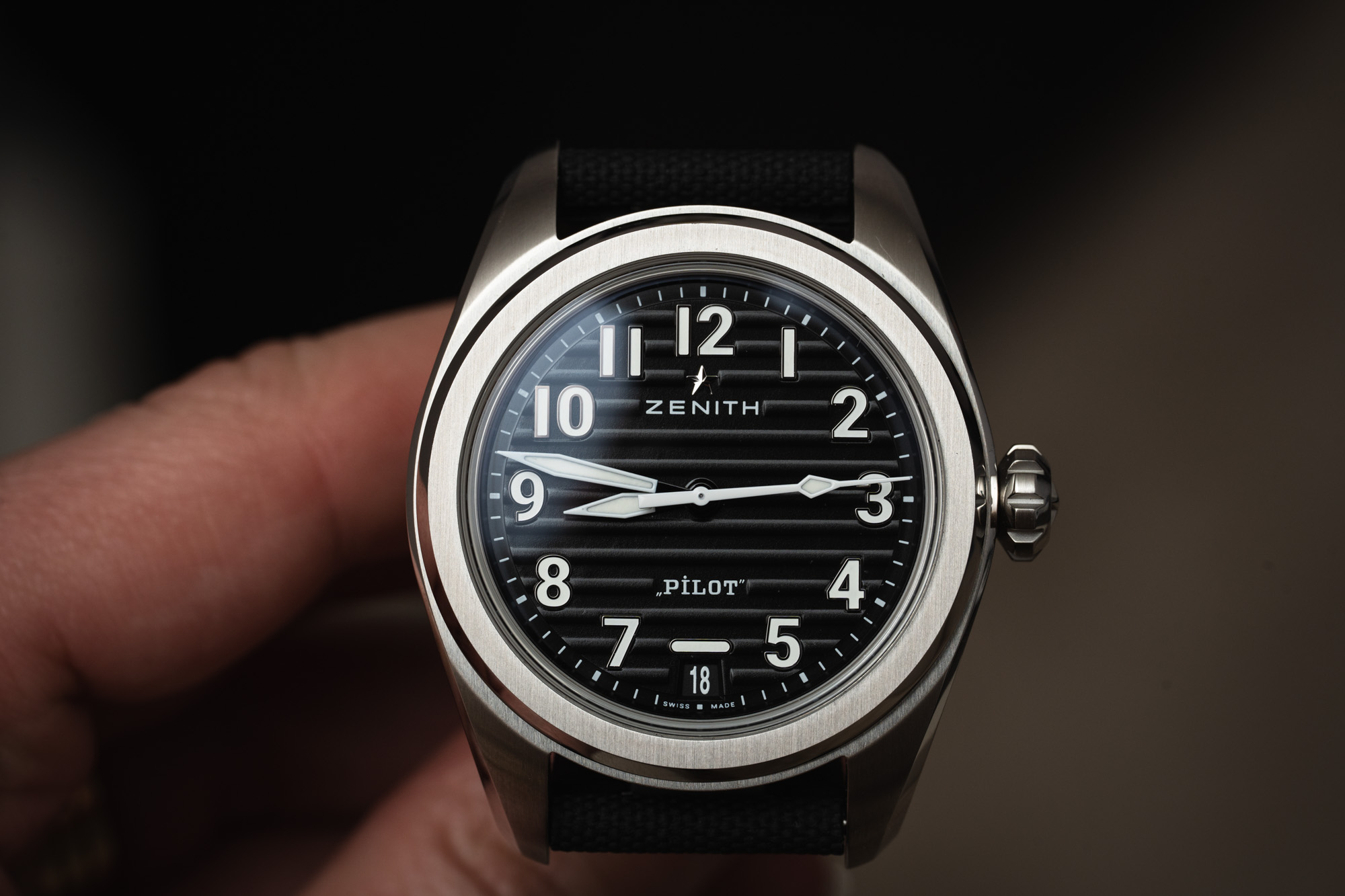
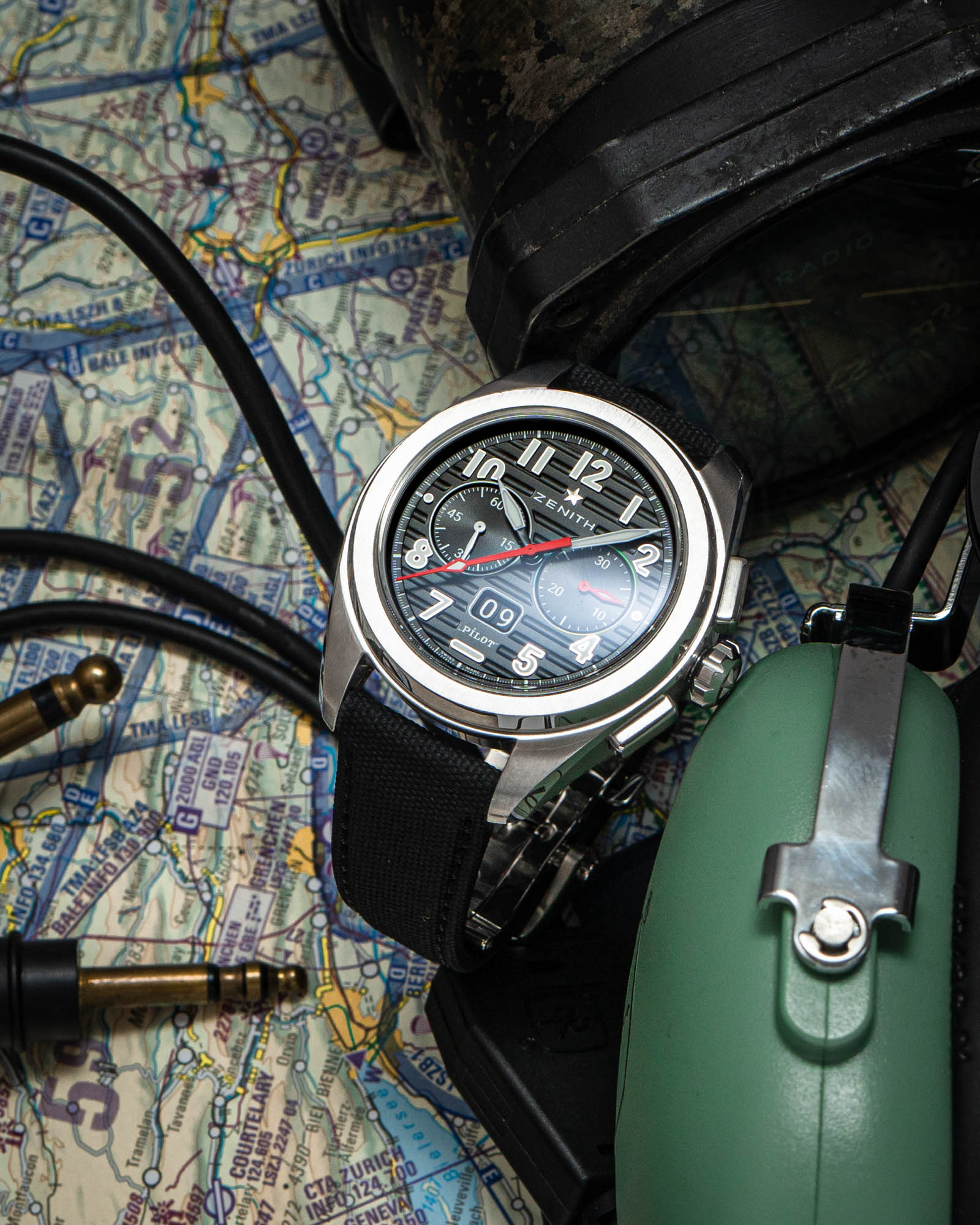 The Zenith Big Date Flyback chronograph dials build on the Automatic’s design brilliantly. With the same handset and markers, two jumbo registers for the running seconds (at 9 o’clock) and chronograph minutes (at 3 o’clock) are accompanied by the namesake Big Date just below the dial’s center. The date’s positioning obviously shifts the “Pilot” text down, and frankly, I felt it looked even better on the chrono than the three-hander. The 6 o’clock lume bar sits parallel with the “Pilot” text, both situated along ridges and without eating into the chapter ring at all. Zenith must be commended for maintaining legibility on these chronos. The large subdials and the use of what I’ll call a jumbo (and lumed) hand on the 30-minute register make reading these watches—the time and the chrono readout—a breeze. On the ceramic chronograph, everything is kept black and white, but Zenith has thrown it back to the 90s for the steel model. In reference (and reverence) to the old El Primero Rainbow Flyback Chronograph, the chronograph hands have been made a bright red, while the 30-minute register features arcs in white, blue, green, and yellow. It’s a subtle use of color that gives the steel model a bit of playfulness while also ensuring that Zenith buffs will have cause for excitement, and it made the steel chrono my model of choice from the new collection.
The Zenith Big Date Flyback chronograph dials build on the Automatic’s design brilliantly. With the same handset and markers, two jumbo registers for the running seconds (at 9 o’clock) and chronograph minutes (at 3 o’clock) are accompanied by the namesake Big Date just below the dial’s center. The date’s positioning obviously shifts the “Pilot” text down, and frankly, I felt it looked even better on the chrono than the three-hander. The 6 o’clock lume bar sits parallel with the “Pilot” text, both situated along ridges and without eating into the chapter ring at all. Zenith must be commended for maintaining legibility on these chronos. The large subdials and the use of what I’ll call a jumbo (and lumed) hand on the 30-minute register make reading these watches—the time and the chrono readout—a breeze. On the ceramic chronograph, everything is kept black and white, but Zenith has thrown it back to the 90s for the steel model. In reference (and reverence) to the old El Primero Rainbow Flyback Chronograph, the chronograph hands have been made a bright red, while the 30-minute register features arcs in white, blue, green, and yellow. It’s a subtle use of color that gives the steel model a bit of playfulness while also ensuring that Zenith buffs will have cause for excitement, and it made the steel chrono my model of choice from the new collection.
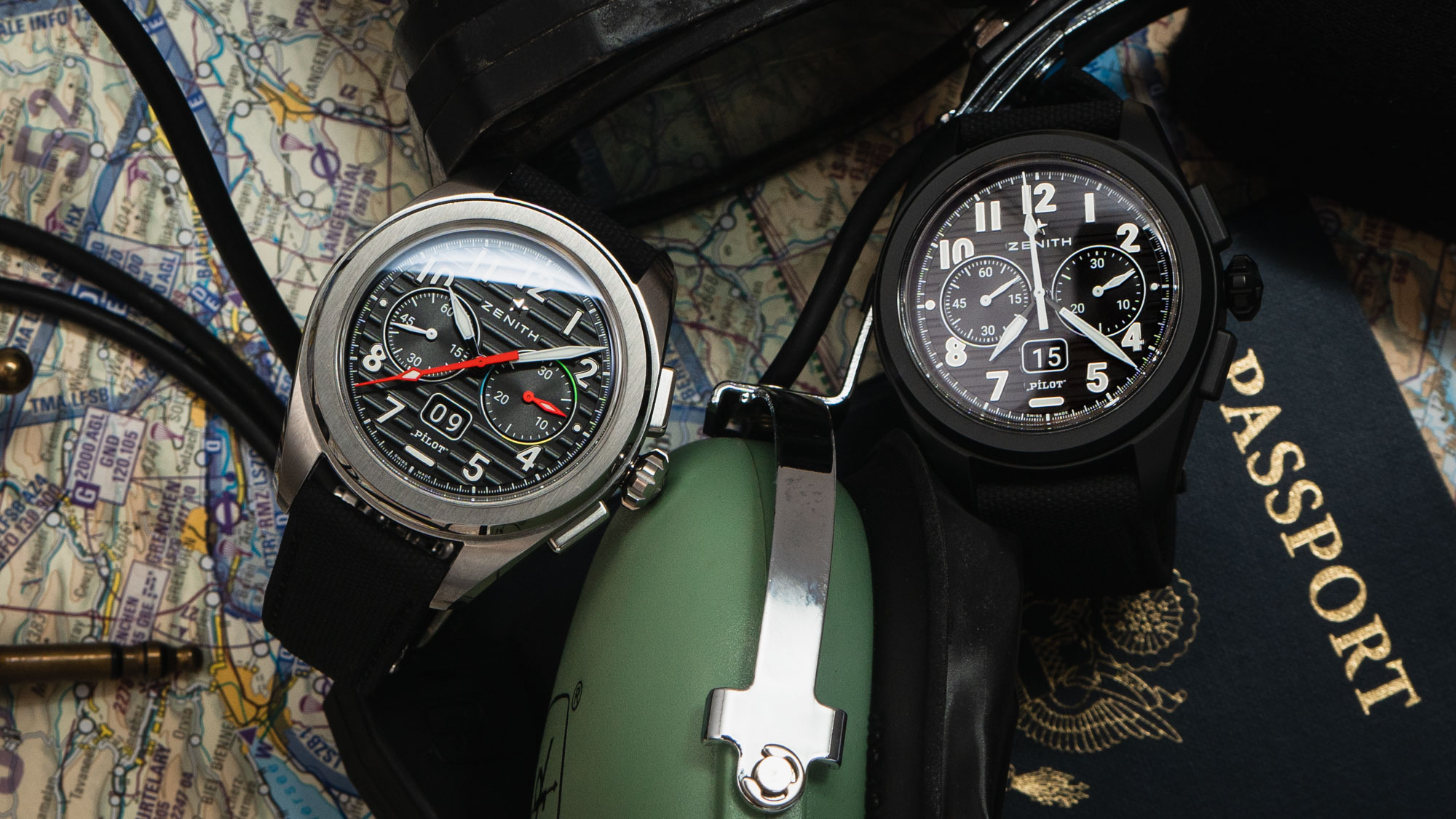 The big date merits its own- discussion. A completely new mechanism was developed involving three patents that allow the mechanism to change instantaneously with blistering speed. When the date changes over at midnight, the mechanism rotates and stabilizes wheels of the big date in 1/30th of a second. The date changes with an audible click that is both satisfying and reassuring (I’m always thrown off when a date function operates soundlessly or without some tactility). Changing the date manually is almost entirely effortless: a fractional rotation of the crown causes the change to occur and so enjoyable was it that I found myself spinning through the date wheel with unusual gusto. Aesthetically, the display also succeeds: the discs are coplanar, avoiding the unattractiveness you find with brands like A Lange & Sohne where one disc sits lower than the other. I’d go as far to say that this is the best big date ever.
The big date merits its own- discussion. A completely new mechanism was developed involving three patents that allow the mechanism to change instantaneously with blistering speed. When the date changes over at midnight, the mechanism rotates and stabilizes wheels of the big date in 1/30th of a second. The date changes with an audible click that is both satisfying and reassuring (I’m always thrown off when a date function operates soundlessly or without some tactility). Changing the date manually is almost entirely effortless: a fractional rotation of the crown causes the change to occur and so enjoyable was it that I found myself spinning through the date wheel with unusual gusto. Aesthetically, the display also succeeds: the discs are coplanar, avoiding the unattractiveness you find with brands like A Lange & Sohne where one disc sits lower than the other. I’d go as far to say that this is the best big date ever.
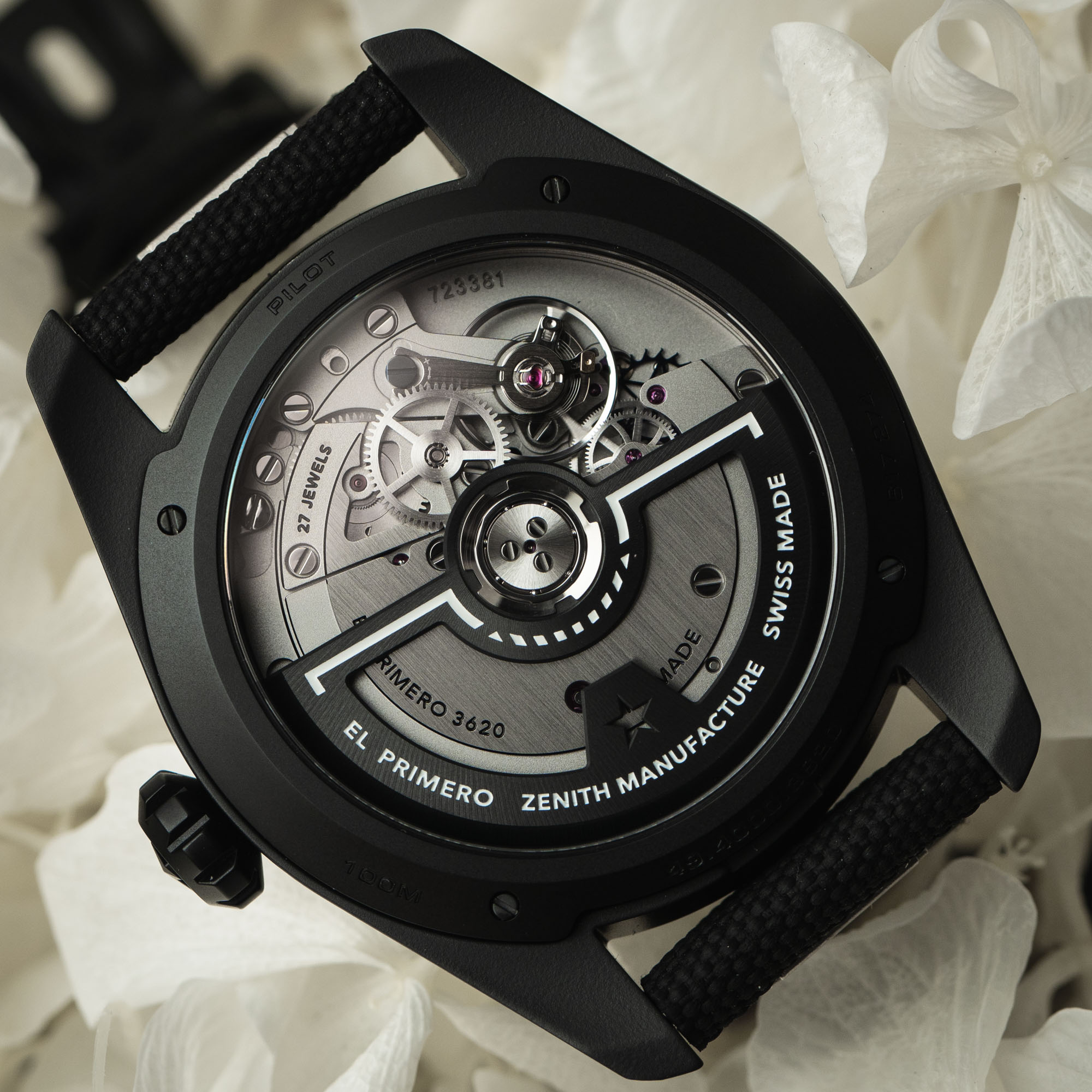
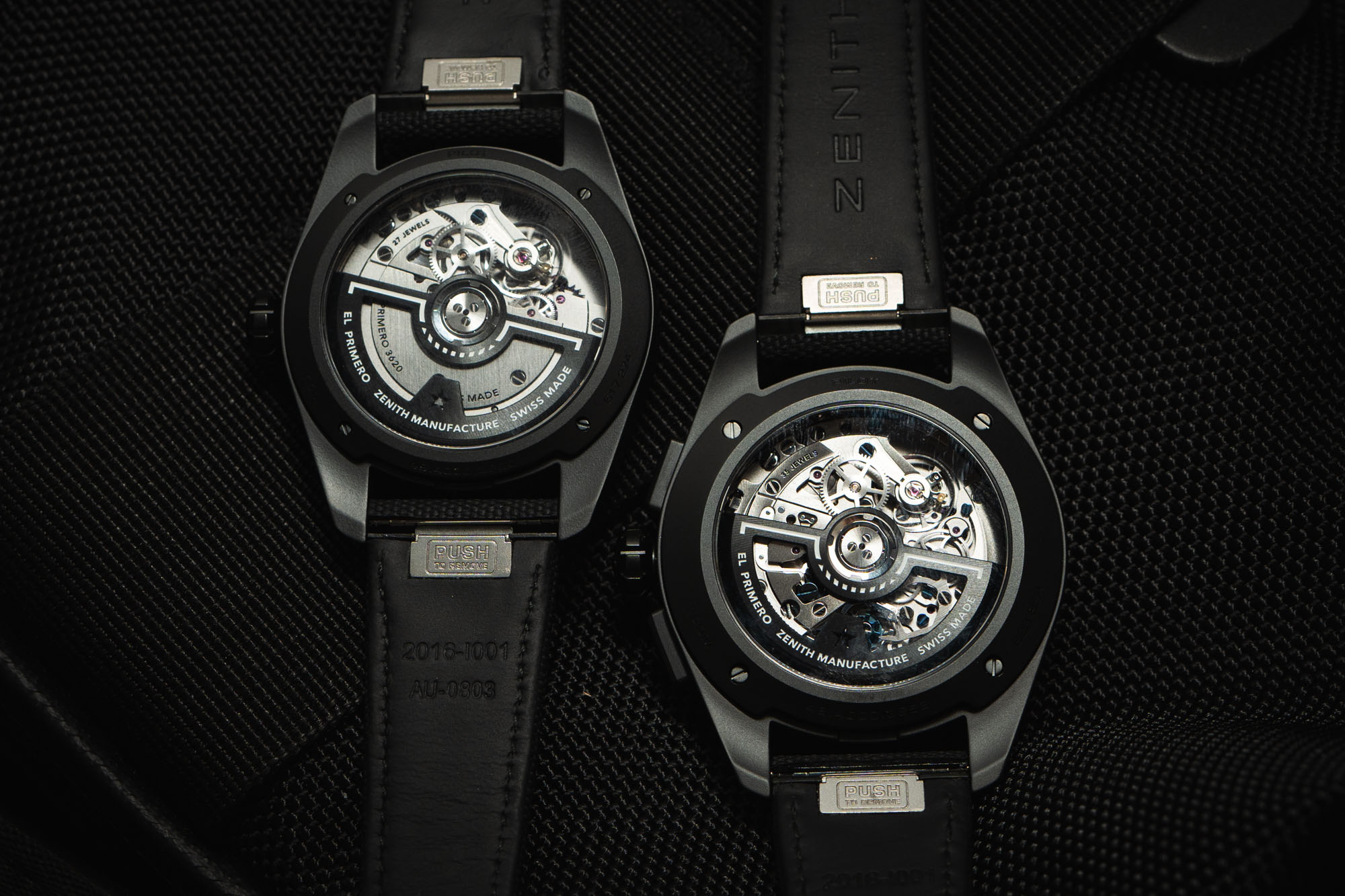 In-house movements are the name of the game here, and of course, both are Zenith’s signature high-beat automatics. In the three-hand Automatic, Zenith uses the El Primero 3620, which has been featured in its Defy line with a 10-second register. Here, of course, the seconds has been converted to a traditional 60-second sweeping center hand. The movement has a nice decoration with a 3/4 plate and runs at 36,000 vph and a 60-hour power reserve. The chronograph caliber is the all-new El Primero 3652 automatic flyback movement. We’ve already discussed the incredible big date mechanism employed within this movement, and it also has a bit more on display than the 3620, omitting the large plate and revealing much of its inner workings. Similar to the 3620, it beats at 36,000 vph and has a 60-hour power reserve. Zenith has fitted both with black skeletonized rotors with arabesque brushing and artificial horizon design borrowed from cockpit instruments, which are exclusive to this collection.
In-house movements are the name of the game here, and of course, both are Zenith’s signature high-beat automatics. In the three-hand Automatic, Zenith uses the El Primero 3620, which has been featured in its Defy line with a 10-second register. Here, of course, the seconds has been converted to a traditional 60-second sweeping center hand. The movement has a nice decoration with a 3/4 plate and runs at 36,000 vph and a 60-hour power reserve. The chronograph caliber is the all-new El Primero 3652 automatic flyback movement. We’ve already discussed the incredible big date mechanism employed within this movement, and it also has a bit more on display than the 3620, omitting the large plate and revealing much of its inner workings. Similar to the 3620, it beats at 36,000 vph and has a 60-hour power reserve. Zenith has fitted both with black skeletonized rotors with arabesque brushing and artificial horizon design borrowed from cockpit instruments, which are exclusive to this collection.
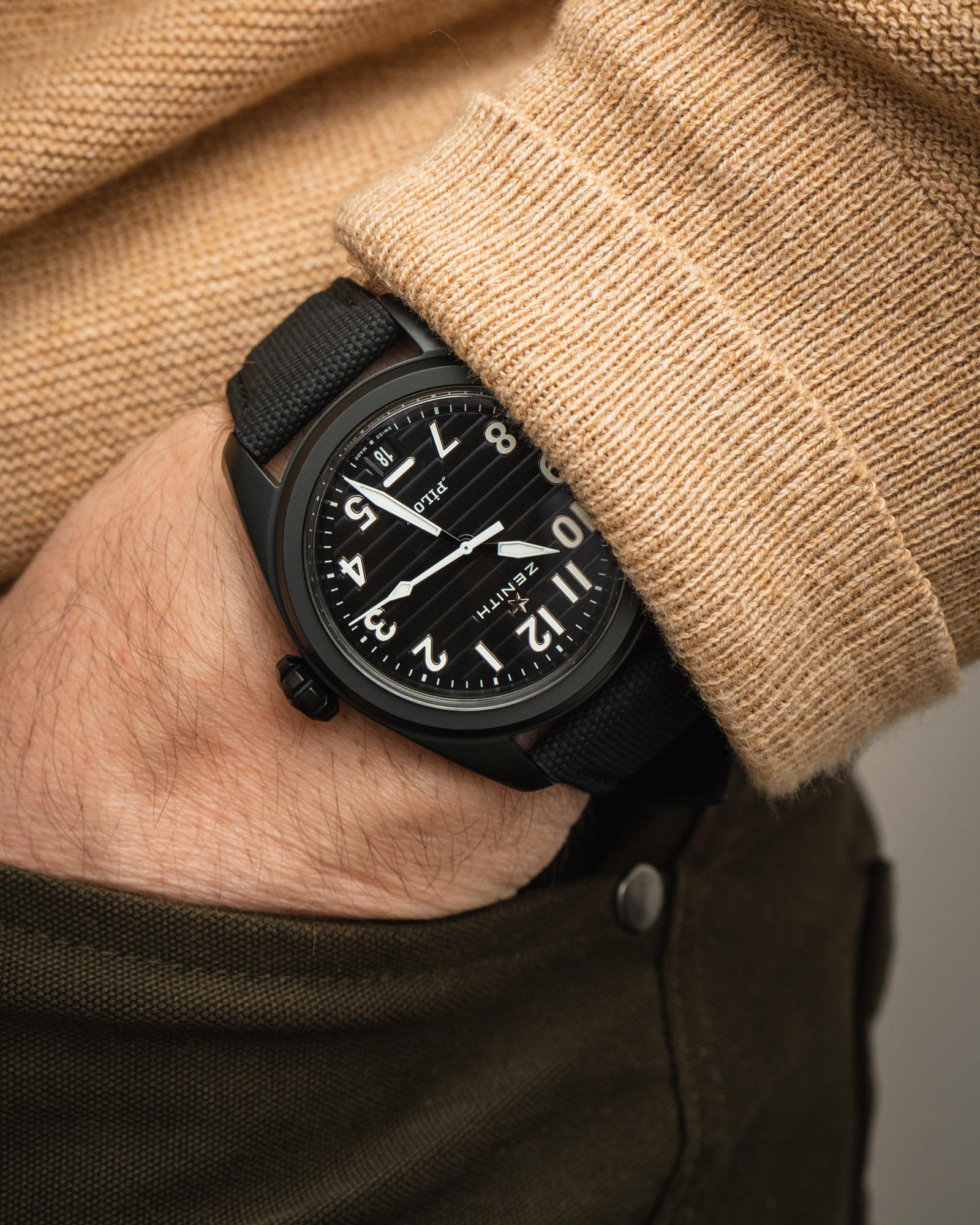
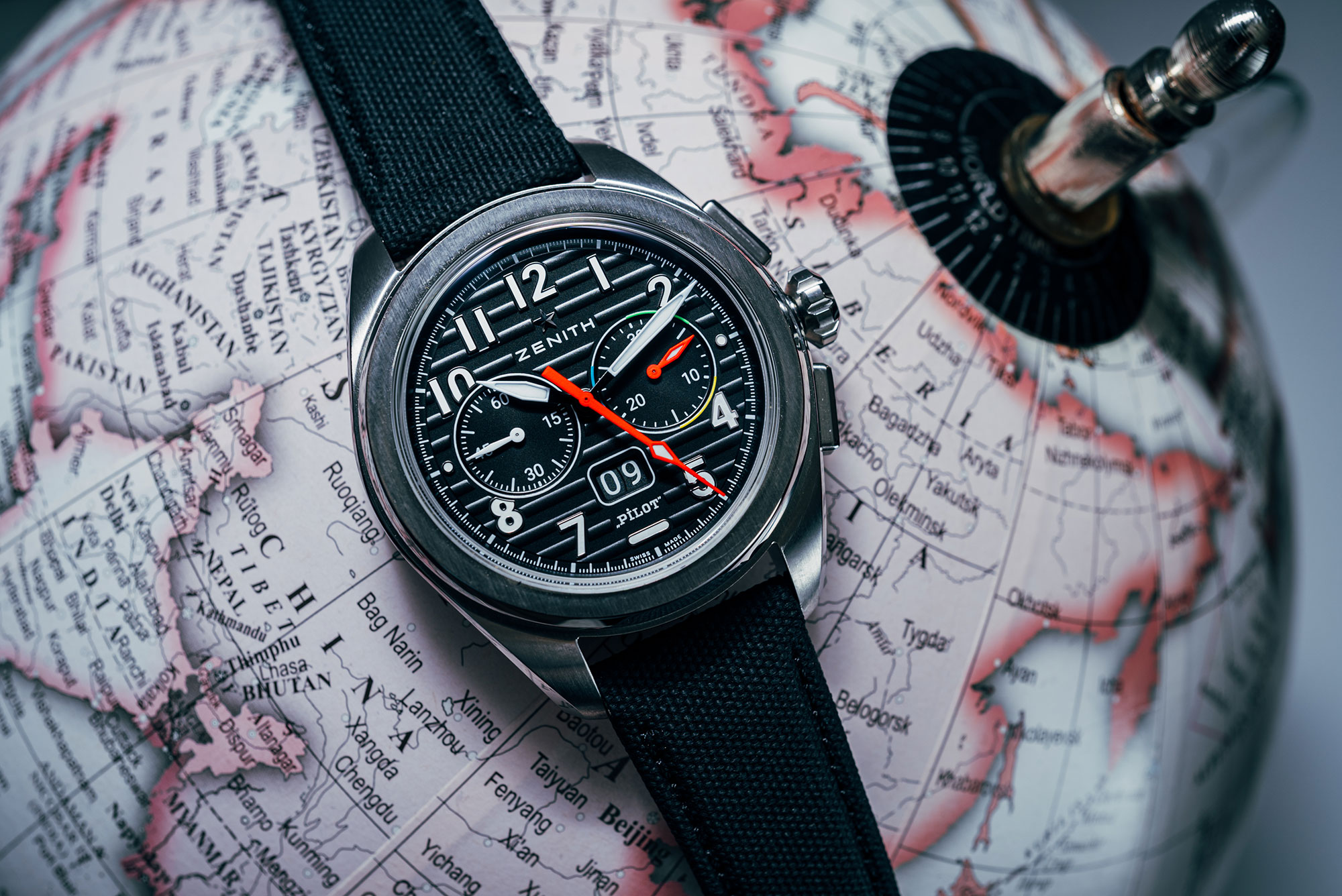 After years of leaving its Pilot collection in apparent limbo, to see Zenith completely redesign the line and burst out of the gate with these four models is the kind of thing we hope for when covering new pieces. These watches bring a modern look to a collection that had languished in the Vintage-inspired Doldrums, combining classic pilot watch elements with fresh design and contemporary proportions. It’s not a stretch to call this one of the best releases from Watches and Wonders 2023. Both Pilot models are available in stainless steel or black ceramic, with The Zenith Pilot Big Date Flyback priced respectively at $11,500 USD and $13,500 USD, and the Zenith Pilot Automatic priced respectively at $7,500 USD and $9,600 USD. For more information, please visit the brand’s website.
After years of leaving its Pilot collection in apparent limbo, to see Zenith completely redesign the line and burst out of the gate with these four models is the kind of thing we hope for when covering new pieces. These watches bring a modern look to a collection that had languished in the Vintage-inspired Doldrums, combining classic pilot watch elements with fresh design and contemporary proportions. It’s not a stretch to call this one of the best releases from Watches and Wonders 2023. Both Pilot models are available in stainless steel or black ceramic, with The Zenith Pilot Big Date Flyback priced respectively at $11,500 USD and $13,500 USD, and the Zenith Pilot Automatic priced respectively at $7,500 USD and $9,600 USD. For more information, please visit the brand’s website.

